Pittwater Aviatrixes on the eve of the RAAF's 100th: A NSW Women's Week - Women of Aviation Week Celebration

On March 31st 2021, the Royal Australian Air Force will mark 100 years of service to Australia. Although the early years of aviation were predominated by men, including numerous Pittwater pilots among these luminaries, this defence service, and Australian aviation itself, is also marked by the efforts and enthusiasm for taking to the blue of Australian women.
As the 2021 NSW Women's Week will run from 8-14 March, including International Women's Day and the NSW Women of the Year Awards, coincides with the March 8-14, 2021 Women Of Aviation Week, a global outreach initiative that takes place annually during the week of March 8, the anniversary date of the world’s first female pilot license earned by Raymonde de Laroche on March 8, 1910, a 'ladies first' delve into some of the women associated with early Australian aviation, as well as the RAAF and Pittwater, is timely.
These women loved motor cars, yachts, motor boats and when they came along, aeroplanes. They were strong willed, held down professional positions for which they had qualified even during eras when gender discriminations meant they could not work or be recognised in their chosen fields, but succeeded anyway.
Among their separate achievements are many firsts for not only Australian women, but women internationally.
Their passion for flight contributed to the RAAF also being a leader for Australian women, as instanced in the WAAF.
The Women's Auxiliary Australian Air Force (WAAAF) was formed in March 1941, after considerable lobbying by women keen to serve and by the Chief of the Air Staff, who wanted to release male personnel serving in Australia for service overseas. The WAAAF was the first and largest of the wartime Australian women's services and set a precedent for the formation of other women's service organisations such as The Australian Women's Army Service (AWAS) and the Women's Royal Australian Naval Service (WRANS). Approximately 27,000 women enlisted in the WAAAF between March 15th 1941 and August 24th 1945.
This had been preceded by the Women's Air Training Corps (WATC) formed in Brisbane in April 1939, founded by Tasmanian born aviator Mary Teston Luis Bell (3 December 1903 – 6 February 1979) as a voluntary auxiliary service for women interested in supporting the RAAF, with state divisions forming soon after. Its members were trained in communications, transport and clerical work for future positions in services such as the Women's Auxiliary Australian Air Force (WAAAF).
Mary married fellow Tasmanian John Bell O.B.E. (1889–1973), a Royal Australian Air Force (RAAF) officer and World War I veteran of the Gallipoli campaign and the Australian Flying Corps, at St Andrew's Anglican Church in Brighton, Victoria, on March 19th 1923. From 1925 until February 1928, they lived in England while John attended RAF Staff College, Andover, and served as RAAF liaison officer to the Royal Air Force (RAF). Mary learnt to fly in England and by April 1927 had qualified for a Grade A private pilot's licence. Mary earned an Australian private pilot's licence in March 1928 when they returned to Melbourne.
There was a local connection in present day Ruskin Rowe being a training camp location associated with the Women's Air Training Corps.
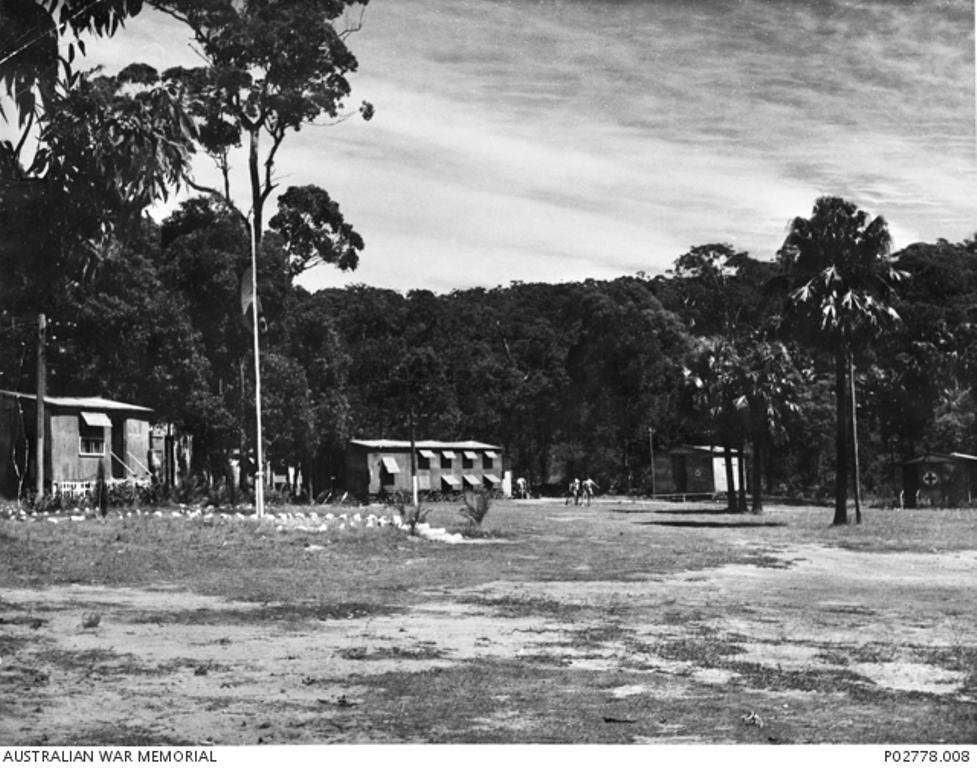
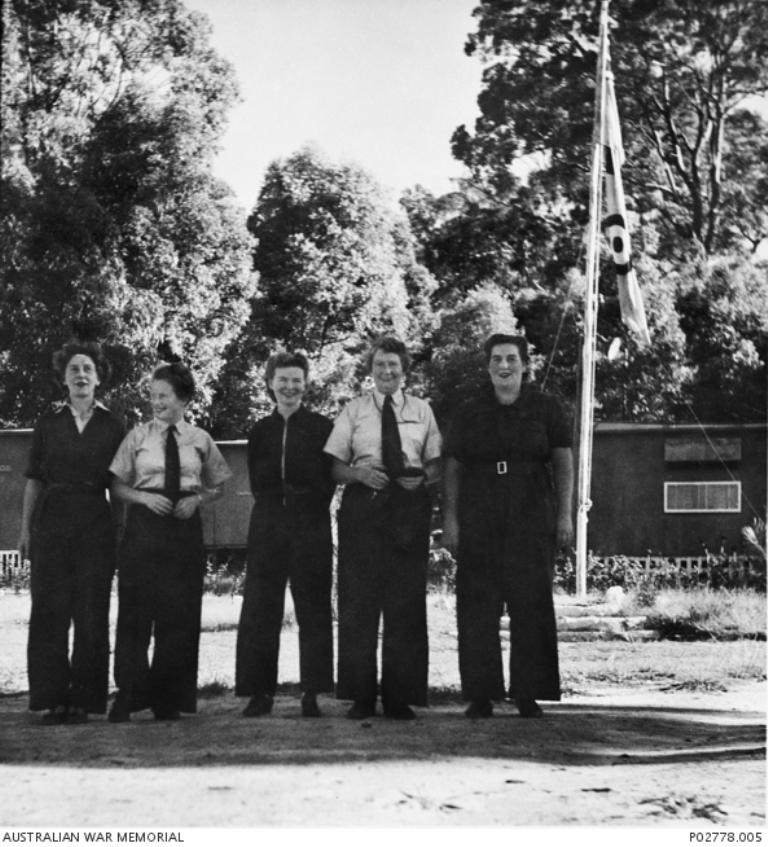
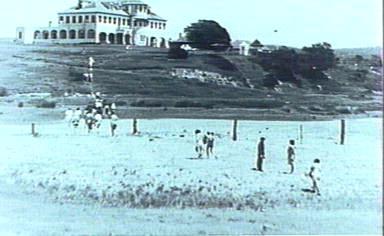
Photo Attributions: TOP: W.A.A.A.F. recruits, Mona Vale, 1944 . FILE: 41\WAR41923 SUBJECTS: Australia. Royal Australian Air Force. Women's Auxiliary Australian Air Force; La Corniche (House : Mona Vale, N.S.W.) ; World War, 1939-1945; New South Wales; Mona Vale; Mona Vale (N.S.W.) DESCRIPT: "La Corniche" commandeered by Air Force during World War II and used as training ground for recruits CREATED: [1944]
Below: Members of Australian Women's Flying Corps, Mona Vale, 1944. FILE: 41\WAR41916 SUBJECTS: Williams, Phyllis; Australia. Royal Australian Air Force. Women's Auxiliary Australian Air Force; World War, 1939-1945 ; New South Wales; Mona Vale; Mona Vale (N.S.W.) DESCRIPT: Phyllis Williams, second from left, back row Photograph taken at "La Corniche" CREATED: [1944]
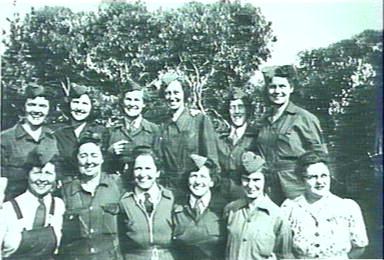
Clare Grant Stevenson
Another Avalon Beach connection is seen in Clare Grant Stevenson, AM, MBE (18 July 1903 – 22 October 1988). Clare was the inaugural Director of the Women's Auxiliary Australian Air Force (WAAAF), from June 1941 to March 1946. As such, she was described in 2001 as "the most significant woman in the history of the Air Force" and became the first head of the first Women’s Service formed in Australia for ground-staff duties with an armed force.
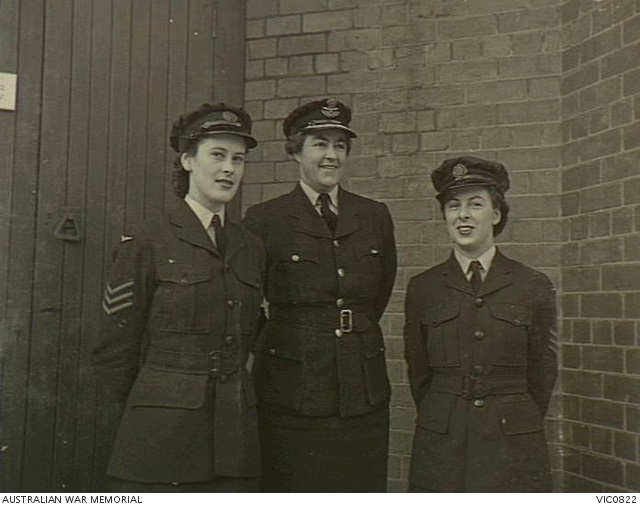
Melbourne, Vic. C. 1944. Three women from one family, all in the WAAAF. Group Officer Clare Stevenson, Director WAAAF (centre) with her nieces Sergeant (Sgt) Warnock and Sgt Grant-Stevenson outside Merton Hall. Courtesy AWM.
Clare Stevenson was admitted to the Faculty of Science and during her time at Melbourne University she was active in campus activities. A member of the Students' Representative Council and the Science Club, Clare Stevenson was a hockey blue and in 1925, president of the Committee of Melbourne University Women. During the final year of the degree she failed chemistry and enrolled for the Diploma of Education, which she obtained at the end of 1925. She commenced her working career as an Organiser of night classes and clubs for day workers for the Y.W.C.A. (Sydney) and in 1932 became a training and research officer at Berlei Ltd.
Clare was a Senior Executive with the Berlei company when she was appointed Director WAAAF. Initially ranked squadron officer, she rose to become group officer by April 1942.
DIRECTOR OF WA.AA.Fs. APPROVES LIPSTICK.
Smokes, Too.
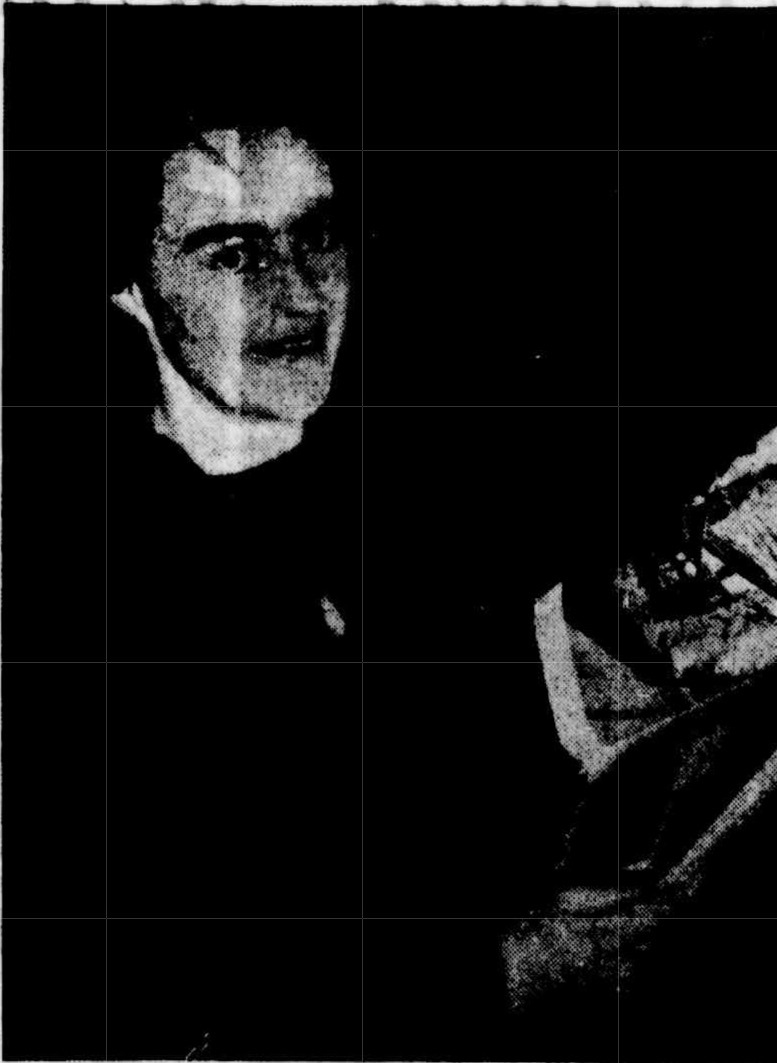
SQUADRON-OFFICER CLARE G. STEVENSON, who yesterday & received news of her appointment as Director of the Women's Auxiliary Australian Air Force, making her the "number one" W.A.A.AT. She holds an executive position with Berlei Ltd., and her rank Is equivalent with Squadron-Leader In the R.A.A.F. She will report for duty in Melbourne on June 9.
Thirty-seven years old, smartly dressed, and with a keen sense of humour, Squadron-Officer Clare G. Stevenson, newly-appointed director of the Women's Auxiliary Australian Air Force, is, by her own admission, "no glamour girl.''.
AS she smoothed her neat brown hair and accepted a cigarette, she said: "I'm a moderate smoker, and, if Air Force regulations permit it, I won't object to W.AA.A".'s smoking. Thank goodness the Air Force is modern enough to allow girls to wear lipstick and use cosmetics. Women look more attractive with lipstick, even in uniform.
"lacquered nails? it's largely a matter of taste. I feel they would be out of place With a Uniform." .
Squadron-Officer Stevenson-her rank is equivalent to that of a squadron officer in the RAAF-regards her appointment as a compliment to Australian business women. She studied science at the Melbourne University, and for the past 10 years has been a member of the Arm of Berlei, Ltd, where she held ah executive position. Her job included training the staff of the company throughout Australia. She also served for six years with the YWCA., and is accustomed to working with all types of girls and women. She has also bad experience in selecting women for different business positions.
"It is an honour to have been selected for this post from among the thousands of highly-trained women in Australia" she said
Squadron-Officer Stevenson feels that the vexed question of women entering the fighting services is a matter of mathematics.
Question of Manpower.
"THE enemy's man-power numerically is greater than ours by millions," she said. ''Even if one Australian is equal to three Germans, we are still behind. Therefore, the time has come for women to release men from non-essential war-time jobs. The Air Force, as the youngest and most up-and-coming of the services, has taken early advantage of being modern in its attitude towards war by taking in women on an official basis.
"Men may resent this, because war Is essentially a man's job. Now, however, the stage has been reached at which wonien nave to 'buck-in' too."
No strict disciplinarian, Squadron Officer Stevenson believes that Interest in the job will create its own discipline among the W.A.A.A.F.S. "Girls who have given up much to join the service, won't present any problems as to discipline," she said.
She has only one regret about taking the new job, and it is essentially a feminine one. "Just think," she said, "how long it will be before I can have the thrill of buying a new hat!"
Squadron-Officer Stevenson will report to R.A.A.F. headquarters, Melbourne, for duty on June 9. DIRECTOR OF W.A.A.A.Fs. (1941, May 22). The Sydney Morning Herald (NSW : 1842 - 1954), p. 14. Retrieved from http://nla.gov.au/nla.news-article17759297
Stevenson resumed her civilian career following her discharge from the Air Force in 1946. Long active in adult education and social welfare, she helped form aid organisations including the Carers Association of New South Wales (now Carers NSW) after retiring from Berlei in 1960.
Clare Stevenson founded the Carers Association of New South Wales, and became its first president in 1980. While serving with COTA in 1974, she had prepared a report titled "Dedication" concerning the levels of assistance given to the elderly by their family and friends. This led to her forming in 1976 a subcommittee of COTA made up of carers, from which she later created the Carers Association as an independent organisation. As president of the association, Stevenson lobbied for the establishment of a carers pension in New South Wales, which was legislated in 1985. She is commemorated at the Carers Association (now Carers NSW) by the Clare Stevenson Memorial Lectures.
In 1981, to commemorate the fortieth anniversary of the formation of women's services in World War II, Ms Stevenson was asked to lead the female contingent in the Anzac Day parade in Sydney. She published The WAAAF Book, a collection of reminiscences by former members of the service, with Honor Darling in 1984.
The Sun Down RAAF Camp at Avalon Beach was not the sole connection to Avalon Clare had. Older residents will recall The Stella James House / Walter Burley Griffin Lodge on the Avalon-Bilgola Plateau verge and on Plateau road itself.
Walter Burley Griffin Lodge is built on an allotment of land known as Lot 342 in deposited plan DP 16902. By October 1933 Griffin had designed a two bedroom stone cottage (weekender) for the Avalon site and it is assumed that it was completed on Lot 342 some time in 1934. Stella Florence James and Clare Stevenson utilised the property as a holiday retreat and weekender. Stevenson had captioned a 1938 photograph of the house by saying she spent many weekends there from when it was constructed in 1933.
Lot 342 was purchased by Stella Florance James (also known as Stella Florence James) and Rose Winter on January 2nd 1936 and Rose Winter's half share was transferred to Stella James in 1941. Lot 343 was purchased by Clare Stevenson in 1939. Clare Stevenson purchased Lot 346 from Sydney Ancher in 1946. Clare Stevenson in Lot 344 in 1953. The fact that Stella James did not own the land until 1936 poses questions as to her relationship with the owner of the land, James Welton of Kings Cross.
Stevenson and James formed a lifelong relationship, living together until Stella's death on June 26th 1974. They lived in a number of apartments in Potts Point over the years but spent as many weekends as possible at Avalon.
Stevenson wrote on the back of a copy of the November 1964 issue of the Trust Bulletin:
'This is the cottage where I spend hundred of weekends from when it was built (sic) 1933 to when I could no longer go when Stella was ill. Too steep to get the chair down' (Robertson and Hindmarsh Pty Ltd, 1993, Conservation Study Burley Griffin Lodge, p8,9).
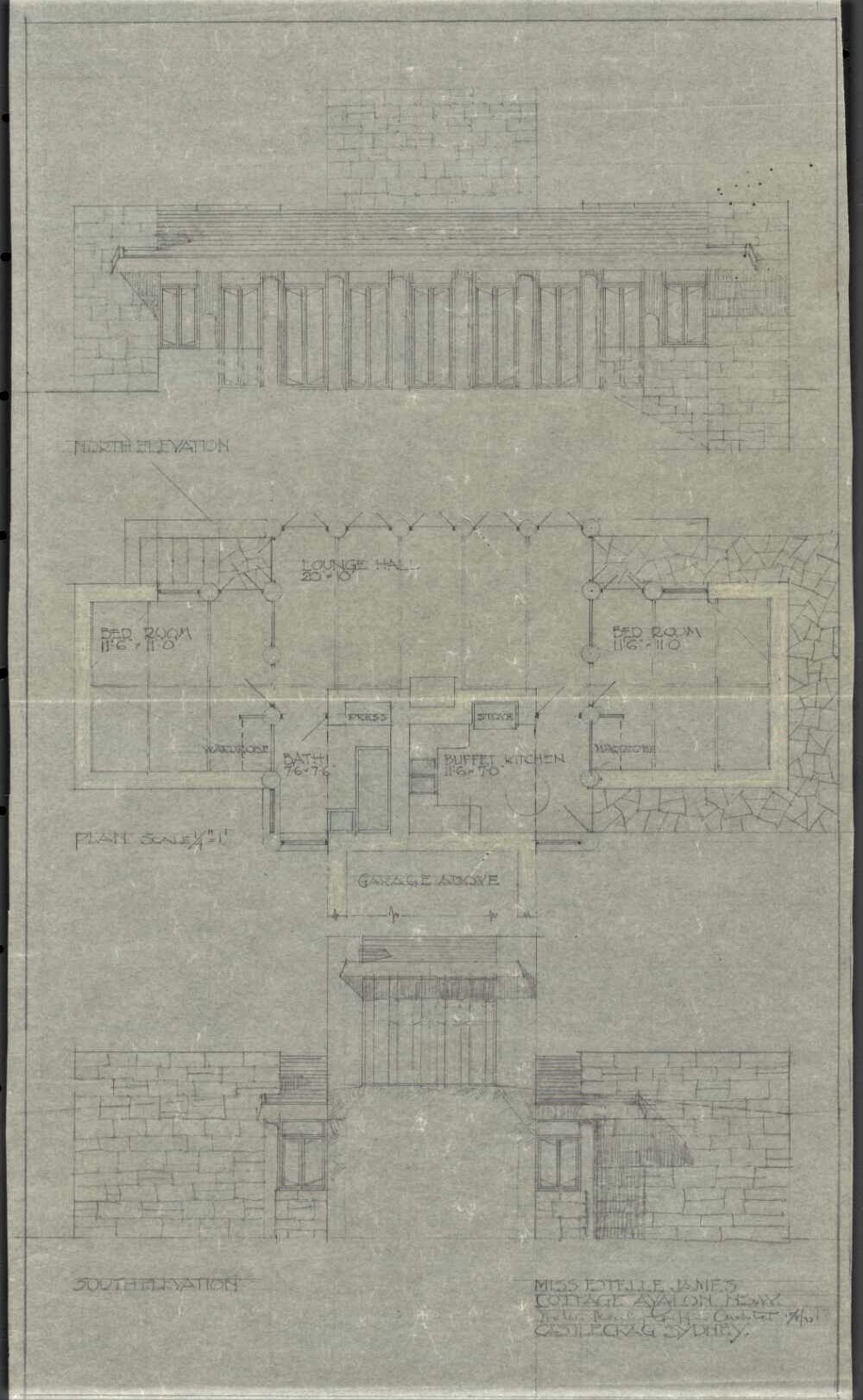
Griffin, Walter Burley. (1933). Sketch floor plan and north and south elevations for cottage for Miss Estelle James, Avalon, New South Wales Retrieved from http://nla.gov.au/nla.obj-150363250
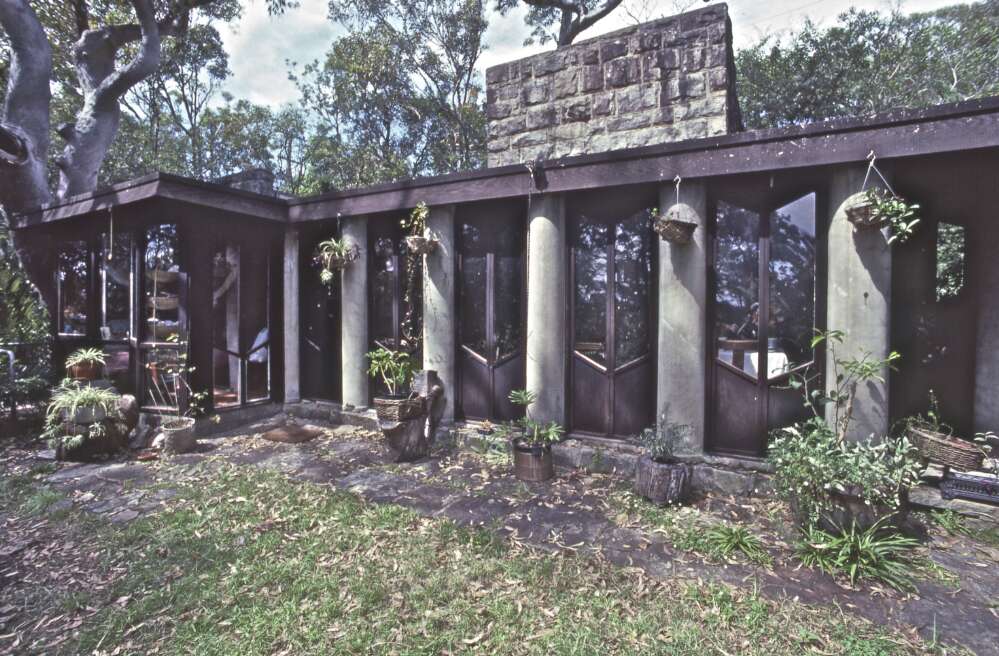
Smith, Robin & Griffin, Walter Burley. (). Exterior view of Burley Griffin Lodge, Avalon, New South Wales, 1934 Retrieved from http://nla.gov.au/nla.obj-152708787
As she was a foundation member of the Forces Reading Room Committee, Squadron-Leader Clare Stevenson found time during her busy trip to Sydney to look in at the opening of the rooms. She is putting in this week-end at the cottage she and Miss Stella James have at Avalon. Who Goes There ... (1941, August 10). The Sun (Sydney, NSW : 1910 - 1954), p. 19. Retrieved from http://nla.gov.au/nla.news-article231632426
The home is a holiday cottage constructed in 1934 on a site that is steeply sloping, featuring tall stands of eucalyptus and angophoras. The house clearly shows Griffins ideal of integrating house with site. The construction is of squared stone blocks, timber framing, with sloping roofs covered with bituminised felt. Accommodation originally comprised a central living area, 2 bedrooms, a kitchen and bathroom, with a garage on a higher level. In the early 1960s architect Sydney Archer sympathetically extended the north - east corner to enlarge the sleeping accommodation.
The property was donated to the National Trust in 1964 at which time it consisted of 6 allotments: Lots 341, 342, 343,344, 345, and 346. Clare Grant Stevenson donated lots 341, 345 and possibly 346, Stella Florence James donated Lot 342 (including the house) and Stella James and Hilda Mary Lyons donated Lot 344.
Clare Stevenson was appointed MBE in 1960 and a Member of the Order of Australia (AM) in the 1988 Australia Day Honours for her services to the community and her welfare work with veterans. Her hobbies included reading, classical music and, in her younger days, surfing. Clare never married and passed away in Mona Vale Hospital on October 22nd 1988 - her Will Notice stated she had been a resident of Collaroy Plateau although in her Will she bequeathed to House with No Steps her beachside property at Narrabeen.
Florence Mary Taylor
The first successful heavier-than-air flight in Australia occurred at Narrabeen Beach on Monday the 5th of December of 1909 and was taken by George Augustine Taylor. This also constituted the first woman to fly in Australia when his wife, Florence Mary Taylor, also had a flight. Over one hundred spectators and media gathered to witness the flight.
The craft Taylor had built was a biplane glider. Constructed from coachwood and covered in oiled calico, with a box-kite tail for balance, the glider had a width of over twenty feet.
They chose a launch area atop the dunes at the north end of the beach and pulled the tethered kite until it ‘nosed’ up into the winds and Mr Taylor called for these lines to be released. He manoeuvred the glider by shifting his weight.
Sources vary but most state that there were between 20-29 flights that day, made in 10-15 knot winds, that reached anywhere from 100 to 250 metres. Flights were made not only by George and Florence Taylor, but also by Edward Hallstrom (later Sir Edward Hallstrom), and Charles and Emma Schultz, who hosted the group at their weekender home, 'Billabong' on the Narrabeen Lagoon, which was then close to present day Birdwood Park.
Reporting on Taylor’s triumphant flight, Aviation journalist, Jack Percival, wrote in The Sydney Morning;
"At 'let go' the wind immediately lifted the machine to the full length of the guide ropes and dragged the operators so fast that two let go; the machine now soared towards the ocean, and at the water's edge the remaining guide ropes were loosened, the machine making a leap upwards. Mr Taylor by careful manoeuvring, kept the machine well under control".
The original report in full:
GLIDING AT NARRABEEN. SENSATIONAL INCIDENTS. AN AUSTRALIAN-BUILT MACHINE.
On Sunday last Mr. George Taylor, secretary of the Aerial League, took a biplane, 18ft long, with 4ft planes, and box-kite tail balance, to Narrabeen. The trials at gliding were held, Mr. Taylor himself acting as demonstrator.
The scene of the flights was at Narrabeen Heads, in the presence of about one hundred visitors, the wide stretch of sand rendering any possible fall a matter of some safety.
At the beginning of the experiments the wind came from the south-east at 10 miles an hour. The machine was carried to a sand knoll, and brought face on to the wind. Messrs. Schultz, Le Clerc, and Gibbons, of Narrabeen, required all their strength to hold it down. For the preliminary flights the corners were held by guide ropes 15ft in length to prevent the machine from getting out of control before the experimenter was properly tuned to automatic balancing.
At the signal to let go the machine was well lifted by the wind, and by careful manipulation on the part of Mr. Taylor it shot towards the ocean 98 yards away in a series of curves from 3ft to 15ft above the ground, dragging its guides, who, however, pulled it to the ground at the water's edge.
Twenty-nine successful flights were made by Mr. Taylor and Mr. Halstrom, an enthusiastic member of the Aerial League.
As the afternoon wore on the flights improved on account of the wind freshening to 15 miles an hour, and coming directly from the east so much so that the last flight of the day was notable.
At "let go" the wind immediately lifted the machine to the full length of the guide ropes, and dragged the operators so fast to the ocean that two let go; the machine now soared towards the ocean, and at the water's edge the remaining guide ropes were loosened, the machine making a leap upwards. Mr. Taylor by careful manoeuvring, kept the machine well under control, and dived it in the sea some little distance from the heads.
The machine will be fitted with steering gear and other improvements for further flights.
Mr. Taylor's monoplane is now having its powerful engine fitted to it at Gibson and Son's motor works at Balmain, and he hopes to have it in the air during Christmas week. If the flights are as successful as anticipated the machine will be placed at the disposal of the military authorities during the Kitchener camp and review. GLIDING AT NARRABEEN. (1909, December 7 - Tuesday). The Sydney Morning Herald (NSW : 1842 - 1954), , p. 3. Retrieved from http://nla.gov.au/nla.news-article15096414
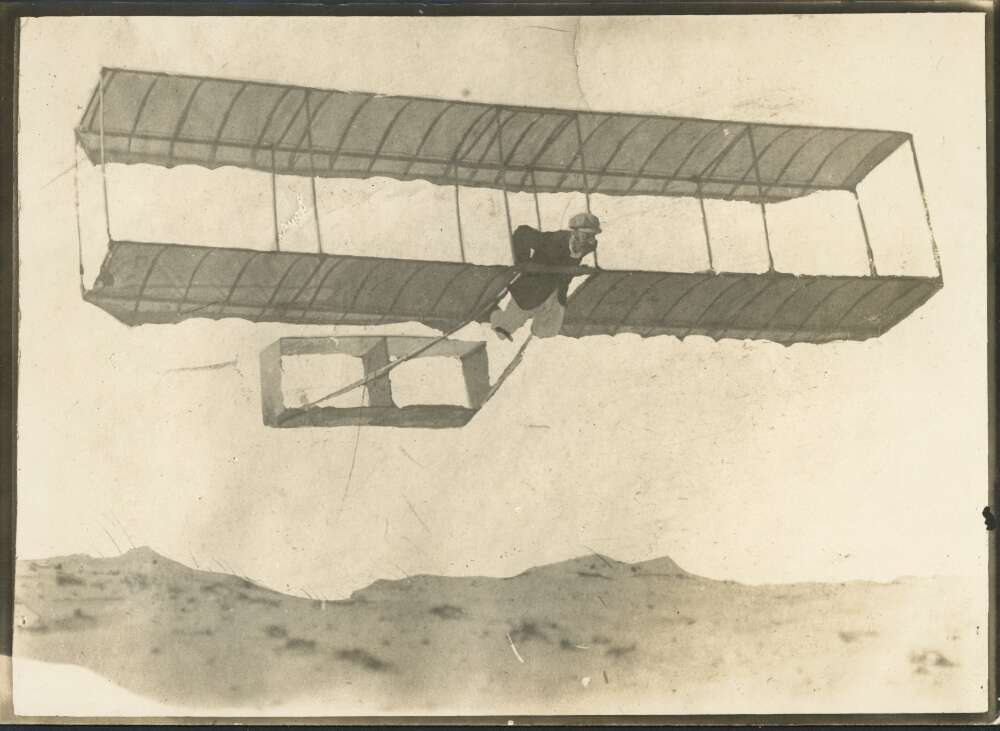
Above and below: 'George Taylor flying at Narrabeen', N.S.W., 1909. Courtesy National Library of Australia. Pictures nla.pic-an24152661 and nla.pic-an24152644
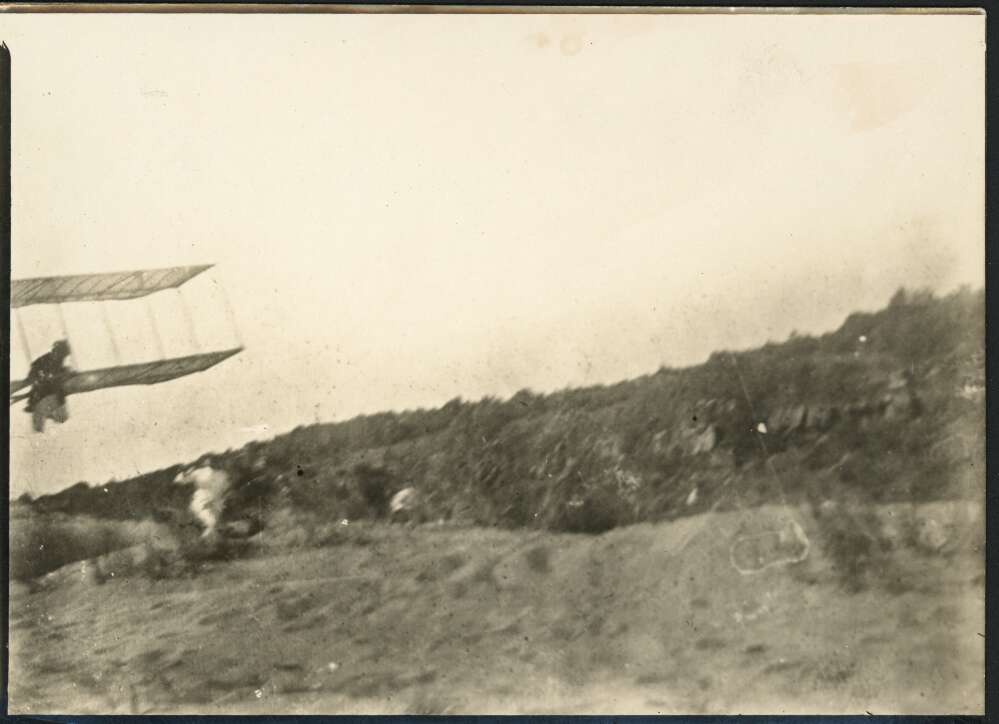
AEROPLANE FACTORY.
The first aeroplane factory established in the southern hemisphere has been started in Sydney. The works are situated in Surry Hills. and consist, of a two-storied building, sufficiently large to allow many full-sized aeroplanes and war kites to be constructed. Eight war kites are now being built, and a large aeroplane is ready to be assembled. Following on the foot-steps of the British authorities, the Sydney factory is paying a lot of attention to war kites.' These models, which are now nearly built, are an improvement of the British productions. The defect in the latter, as in most large kites, was that they required a very strong wind to lift them. With the local variety, however, this, it is claimed, has been got over, owing to simpler construction and modified ideas- all of which will tend to perfect this type of flying machine.
Mr. George A. Taylor, Secretary of the Aerial League, said that the possibilities of the man-lifting kite have not yet been fully realised. He considered that the war kite-simple to build, cheap, and compact, can be more easily transported in the field of operations. For a place like Australia, he contended, with her wide unpopulated areas and lack of communication, and with lonely scattered defences- war kites, especially if fitted with wireless telegraphy, will be preferable to torpedoes, Dreadnoughts, or aeroplanes. This type of flying machine possesses advantages over military balloons, Mr. Taylor thinks, as any variety of the latter is difficult to transport, if not impossible, owing to the cost of gas. cylinders, and expense of up-keep. The model, which looked enormous, was shaped somewhat like the wings of a bird. The arms on each side measured 15ft., or 30ft. across from tip to tip. Below these wing-like planes is another smaller pair, the height from the lower to the upper set being 10ft. This new war kite showed that wonderful thought has been expended, with a view of obviating wind resistance and vacuums, which in all air vessels is one of the greatest difficulties to overcome. Unlike other models produced in England and the Continent, the Sydney varieties have the planes curved upward, so as to give a lifting power of their own.
A frame of a full-sized aeroplane is only awaiting its engine from Melbourne before being tested with other war kites at the aviation display to be held late this month. An interesting feature of the latter demonstration will be the installation of wireless telegraphy. Some of the kites to be flown will be supplied with this method of communication, and will prove no doubt of interest, seeing that the coming military manoeuvres are near at hand. Mr. Taylor, in exposing some of the material ready to be adopted in his kites and aeroplanes, said that the possibilities of wireless telegraphy should especially appeal to Australia, as it will be the means of bridging silent spaces in a way hitherto impossible.
''We will have 50 aeroplanes in use by the Government within the next few years. War kites-they will be in common use, and wireless telegraphy will be fitted to them. Had the Waratah been fitted with wireless telegraphy her messages could have been received by war kites over many times the distance that would have been possible with an ordinary receiving station. That shows you the great possibilities of these handy reliable, and cheaply-made methods of flight." AEROPLANE FACTORY. (1909, October 7). Clarence and Richmond Examiner (Grafton, NSW : 1889 - 1915), p. 8. Retrieved from http://nla.gov.au/nla.news-article61502009
Florence Mary Taylor CBE (née Parsons; 29 December 1879, Bedminster, England – 13 February 1969, Sydney, Australia) was the first qualified female Architect in Australia. In April 1907 she married Sydney-born Artist, Inventor, Craftworker and Bohemian George Augustine Taylor at St Stephen's Presbyterian Church in Sydney. George had lectured at her college and was a close friend of her first employer Francis Ernest Stowe.
Both passionate about architecture and town planning, and so, within a few months of their wedding they established a publishing company, Building Publishing Co. Ltd that specialised in building industry journals, spearheaded by Building magazine, three of which Florence edited: Harmony, Young Australia and the Australian (later Commonwealth) Home. According to garden historian Richard Aitken, 'Gardening, although not expressly covered by Building, was treated nonetheless as an integral part of design, both at a domestic level and on a broader public scale'. Florence's secretary was Mary Emily Haworth (1901–1998), who was the maternal grandmother of Australian artist Kathy Panton (1969–). Journalist John Canner (1882–1978) also worked on "Building Ltd" where he met and later married Mary Haworth.
For some years following their marriage the Taylors lived in Bannerman Street, Cremorne, in a house designed by the innovative architect, Henry Austin Wilshire, before moving to an apartment on Loftus Street, Sydney, where their publishing business was also located. In 1913 they were founding members of the Town Planning Association of New South Wales, and Florence served as its secretary for many years.
Following her husband's sudden death, drowning in his bath associated with an epileptic fit in 1928, Florence maintained their publishing business and while forced to close eight of their eleven journals, she maintained Building (later Building, Lighting and Engineering) (1907–72), Construction (1908-74) and the Australasian Engineer (1915–73), editing them herself and expanding significantly after World War II. She continued to produce town plans and also travelled to Asia, the Americas and Europe bringing back ideas on town planning which informed her writings and speeches.[2] She published a book about her town plans in 1959, authored by her employee J.M. Giles, Fifty years of town planning with Florence M. Taylor. Taylor was appointed an Officer of the Order of the British Empire in 1939 and elevated to a Commander of that order in 1961. She was outspoken, fiercely independent, didn't think much of unions or those who would not strive to do their best.
In 1907 Florence applied to become the first female member of the Institute of Architects of New South Wales. However she was not accepted at this time, and later claimed to have been "blackballed" by a groundswell of hostility from the all-male membership who did not wish to admit a woman member - an attitude that prevailed at that time, and so soon after women had been given the right to vote. Florence eventually became their first woman to be associate member having “practised as an architect and at present is serving in an advisory capacity to architects as well as assisting in the production of “The Building Magazine”" but it was not until the early 1920's that she was admitted as a full member.
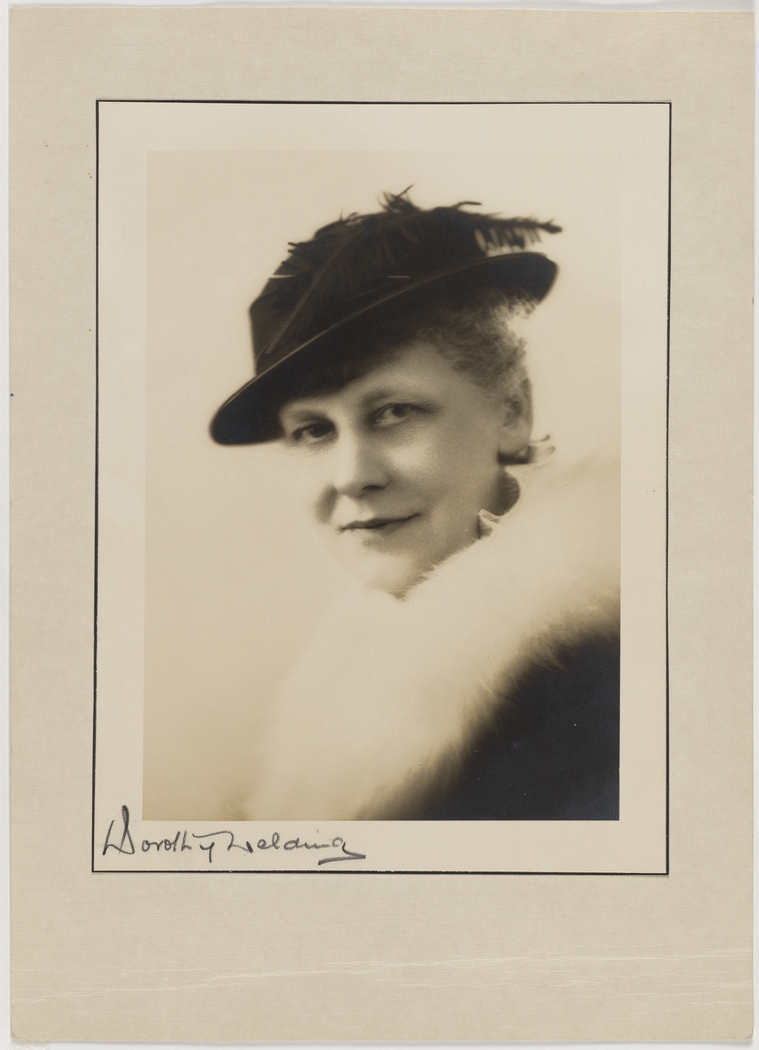
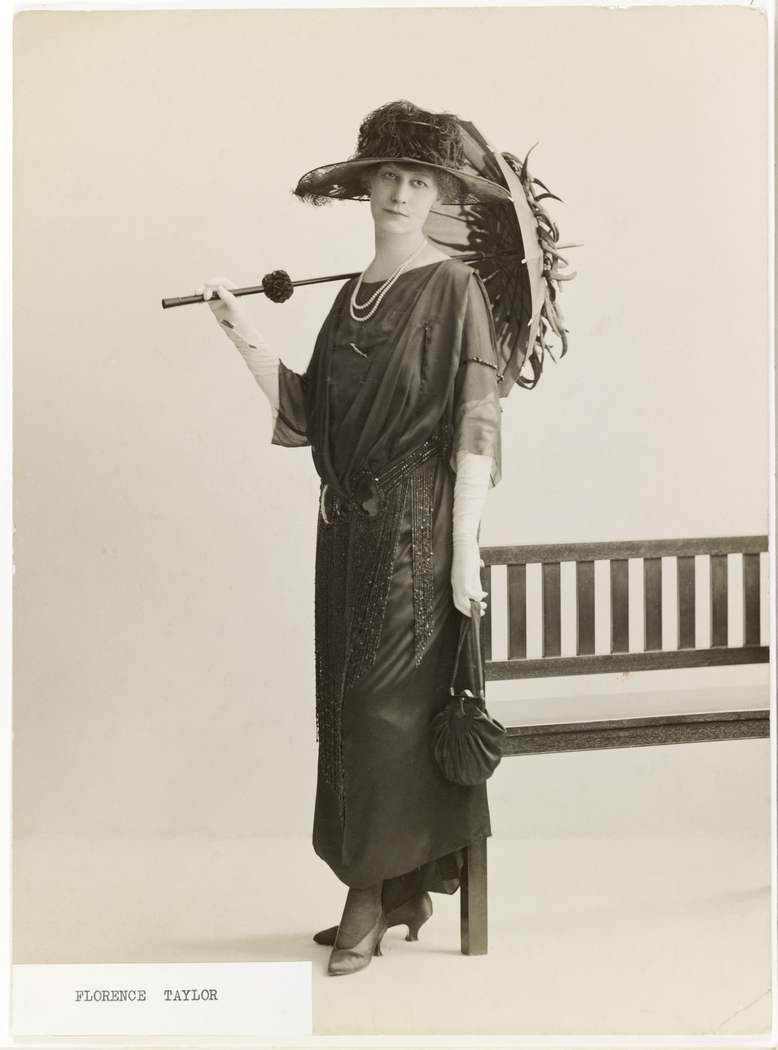
Florence Taylor, Items a1382002h and a1382004h, top image taken by Dorothy Welding, courtesy the Mitchell Library, State Library of NSW
A WOMAN BUILDER.
Building is a very new profession for women, there are only two women architects in England. Mrs. Florence Parsons Taylor, who is the bride of Mr. George A. Taylor, the cartoonist, is the sole qualified woman architect in Australia. Five or six women have begun to study the profession in Sydney, but Mrs. Taylor heard of none in Melbourne, which she lately visited in connection with the Women's Exhibition. Some of those who began to study architecture in Sydney have given it up.
Mrs. Taylor struck out in this direction because she was obliged to earn her living, and to support some of her family, and the pay for women's work seemed to be so small in other directions. "One of my sisters went to a studio and earned 7s 6d a week, and another was in a large stationer's getting 82s 6d. You know that sort of thing does not keep a family together."
"And does architecture pay?"
"I have mothered and fathered my young sisters, given them a good education, and acquired a home for the family out of it."
"The reason I have done so well," Mrs. Taylor modestly adds, "is that there are so few women taking up the profession. Type-writers, when they were a novelty, could earn £5 a week, but that rate is seldom paid now.
"There Is plenty of opposition to be faced. The older men in business have been very kind to me, but the young men who were studying when I was resented a woman going in for architecture. 'Taking bread out of men's mouths' they called it. I said to them once, 'Haven't I a mouth, and haven't my sisters?' "
"What new developments are taking place in building?"
"There is very little that is new that is worth commenting upon. Master minds have for years past fixed all their attention on the subject, and don't you think we should do better to study the results of their brain, and try to learn from them, than to be incessantly " endeavouring to find something new? The (ordinary dwelling-place must be built as now; there can be little improvement. There are some general rules that should be followed: The bedroom should face east, and the sitting rooms north and south. People are surprised (When they see the house I have built for my-self to find the laundry is on the corner of the land. I put it there because I wanted the sitting rooms and verandahs to face north and south. In this way we got a breeze right through the house, and our bedrooms get the morning sun."
"Surely there are some changes that have to be made from the old style, owing to this climate?"
"Houses are adapted to the climate in many cases. You don't see in England (where I was born) verandahs or balconies round the houses. The steep-pitched roofs are used here, though, and are a great mistake. There is no snow or hail to throw off, so they are quite unnecessary."
"Do you like cosy corners?"
"Yes, I often put them. Bay windows? Yes, they look very well."
Mrs. Taylor has not found many people asking for the new fireplaces (built at a height from the ground) that are now seen in every second house in Melbourne. People who build do not care much for suggestions that involve expense, as new ideas always do,
"House-building is very expensive, and it is going to cost still more. Some houses are cheaply built, but they are not fit to live in. I wouldn't build that kind of house. An architect receives 5 per cent, on the outlay if she supervises all the work, and 2 percent if she merely draws up the plans." "How.do you become known?"
"Only through my work. It is against etiquette for an architect, as it is for a doctor, to advertise. Very silly, I think. The kind of houses I build range from £600 to £1500 mostly."
"And you have done well at them?"
"As I told you, I have reared a family on the proceeds." A PAGE FOR WOMEN (1907, December 11). The Sydney Morning Herald (NSW : 1842 - 1954), p. 5. Retrieved from http://nla.gov.au/nla.news-article14896422
MRS. FLORENCE TAYLOR.
ARCHITECT AND TOWN PLANNER.
Mrs. Florence Taylor, who had the distinction of being the first woman to be elected to the Institute of Architects, has now the honour of being the first woman to be ap-pointed to office on the Town Planning Association. She has been elected vice-president, and is the only woman in Australia who has become prominent in LU work.
Mrs. Taylor served her articles under Architect Edward S Garton, and worked as chief draftsman in the offices of some of Sydney's most prominent architects before herself practising as an architect She holds certificates from the 'University of Sydney and the Sydney Technical College covering geometry, free-hand drawing, perspective drawing, architectural drawing, building construction, and quantity surveying. She is a member of the Society of Architects, London, as well as of the Institute of New South Wales. MRS. FLORENCE TAYLOR. (1922, February 10). The Sydney Morning Herald (NSW : 1842 - 1954), p. 5. Retrieved from http://nla.gov.au/nla.news-article15961902
Her legacy as a town planner is more extensive as many of the ideas she advocated for Sydney have come to fruition in recent decades including a harbour tunnel crossing, an eastern suburbs distributor freeway, the construction of "double-decker streets" such as the Victoria Street overpass across William Street at Kings Cross, increased building of apartments especially in harbourside localities such as Woolloomooloo and North Sydney, more flexible mixed-use zoning (including longer shopping hours), making Sydney more attractive for tourism and the need to conserve and plant trees. Other ideas have proved unpopular or incorrect, such as her desire to demolish Hyde Park Barracks or build heliports in the CBD and her contention that the Sydney Opera House would be a white elephant. Florence remained closely involved in the Arts Club, (Royal) Aero Club of New South Wales, Society of Women Writers, the New South Wales branch of the Australian Forest League, Australian-American Association, Royal Empire Society, and the Bush Book Club. Her fellow members of these clubs had connections and holiday homes throughout Pittwater.
FLORENCE TAYLOR, OUR FIRST WOMAN ARCHITECT AND ENGINEER
MRS. FLORENCE MARY TAYLOR, O.B.E., A.R.A.I.A., ! L.R.I.B.A., A.I. Struct. E, (Lond.); was the first woman architect and structural engineer in Australia. Forty years ago she gained her certificates for architecture, building construction, and ! quantity surveying, and began a career on which she has based a diversity of activities i that have won her fame and r affection among women throughout Australia. Born December 29, 1879, at Bristol, England, she came to Australia when four years old. ,v-When she was 19 her father died, leaving her to provide for her two younger sisters. - To do this adequately she studied to be an architect, and became the pioneer for women in this profession. Before she was 26 she was responsible for building about 100 residences in Mosman, Neutral Bay, and Darling Point areas.
World's Only Woman Technical Publisher
She is publisher of well-known periodicals, journalist, town-planner, worker for the arts. She is editor and proprietor of the periodicals "Building and Engineering'' (the official journal of the Master Builders' Association), Australasian Engineer" (official journal of the Local Government Engineers), and "Construction'' Also managing director of Building Publishing Co., which produces them. In no other part of the world is a woman conducting a business solely concerned with the publication of technical knowledge. With the exception of one woman architect, Mrs. Taylor's subscribers are all men. So keen is Mrs. Taylor's interest in her work she lives on her business premises, at 20 Loftus Street, Sydney. -
Her library is her office. She works surrounded by a faceless collection of technical books. In 1907 she married George Taylor, architect, engineer, and journalist. Since her husband's death, 17 years ago, she has run the publications and printery. She was probably the first woman glider in Australia, making a flight from the Narrabeen sandhills in 1908. With her husband, she founded the Town Planning Association" about. 27 years ago, and is a life member; of the association. With the late Sir John Sulman she represented the Institute of Architects at a conference at the Royal British Institute at Oxford in 1924. ....
.jpg?timestamp=1615031643732)
.jpg?timestamp=1615031709747)
.jpg?timestamp=1615031810915)
.jpg?timestamp=1615031776602)
.jpg?timestamp=1615031881456)
.jpg?timestamp=1615031917158)
.jpg?timestamp=1615031949887)
.jpg?timestamp=1615031983780)
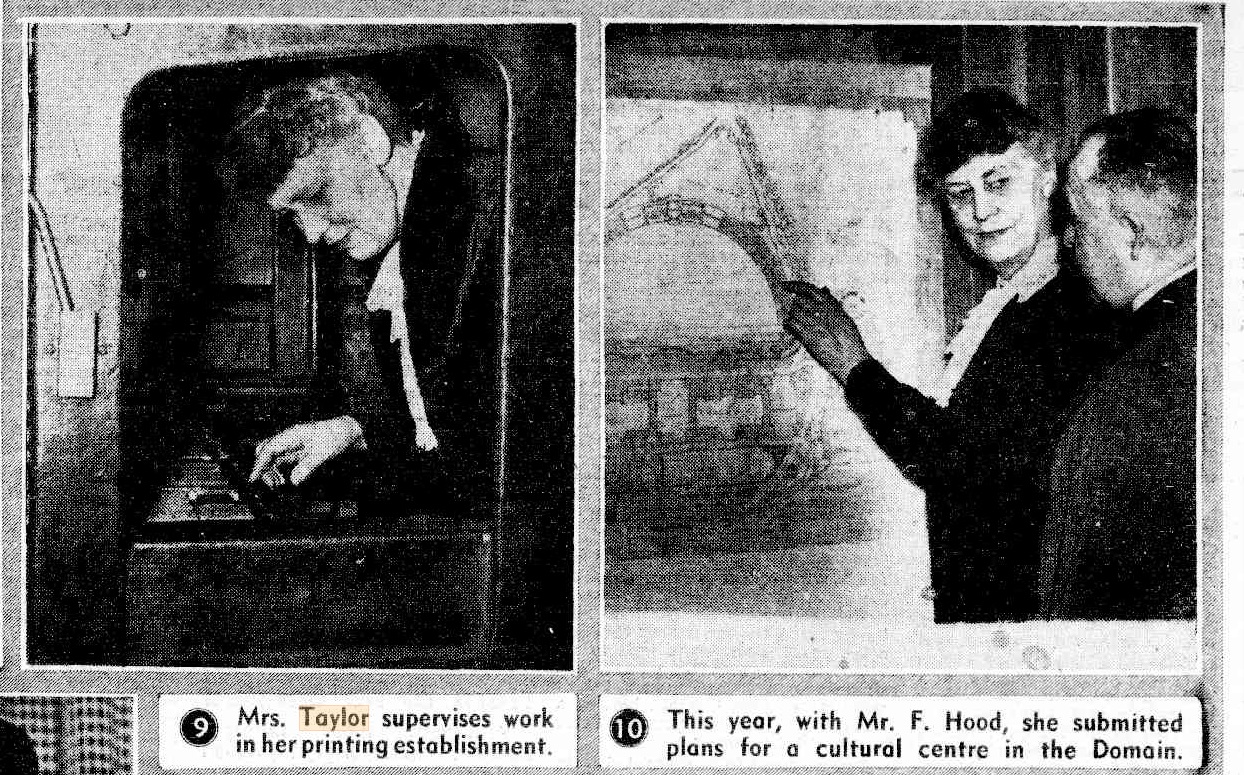
.jpg?timestamp=1615032059921)
Mrs. Taylor 40 years ago at the beginning of her career. Continued her career after marriage, but was never too to motor with her sister. Crossing Atlantic in 1924 with Doug. Fairbanks, Mary Pickford. While in England to attend conference of architects she was presented at Court in 1924. Three years before this experimental flight in England in 1911 she had glided over Narrabeen. Mrs. Taylor, on the right of Lady de Chair (centre back), founded the Arts Club in 1928. Included are Ladies Allen, Taylor, Murdoch, Cook and Lyne. Congratulating New Guardsman de Groot on severing ribbon before then Premier Lang at Sydney Harbor Bridge opening, 1932. Responding to congratulations at a reception in June, 1939, on her award of O.B.E. Mrs. Taylor supervises work in her printing establishment. This year, with Mr. F. Hood, she submitted plans for a cultural centre in the Domain. Florence Taylor as she is today—efficient business executive, professional woman philanthropist, musical, literary, and... spheres;' FLORENCE TAYLOR, OUR FIRST WOMAN ARCHITECT AND ENGINEER (1945, August 2). The Daily Telegraph (Sydney, NSW : 1931 - 1954), p. 14. Retrieved from http://nla.gov.au/nla.news-article247631116
Almost two decades after those first Narrabeen jaunts above land Florence would recall these flights went on until the gliders they were made in were 'lost at sea':
Christmas in Many Lands
: — Happy Recollections Of Sydney Women PARIS, SAMOA, MARSEILLES, NARRABEEN
The early days or Aviation in Australia are connected with Christmas in the memory of Mrs. Florence Taylor: —"The gladdest Christmas in my life —and they were all too glad to relegate one behind another — was spent at Narrabeen, when husband, aviation bent, practiced gliding on Narrabeen shore. The boy-enthusiasts came practically every Saturday— all uninvited, and those who could not afford the 'bus fare (trams were not running in those days), walked seven miles there and back to Manly. Mrs. Schultz turned her grounds into hangars, and entertained us all weekly. Friendships among the gliding enthusiasts grew. By 9 or 10 on Christmas evening a hundred visitors and neighbors revelled in the freedom and gaiety that friendship alone can bestow. This happened for about ten years, until the gliders, lost at sea, no longer attracted the enthusiasts, who started to thin out." Christmas in Many Lands (1928, December 23). The Sun (Sydney, NSW : 1910 - 1954), p. 35. Retrieved from http://nla.gov.au/nla.news-article223240530
Even decades later Florence would be standing up for Narrabeen's beauty, and after WWII came up with a scheme for an aquatic airport at Newport - perhaps to rival that at Rose Bay, perhaps in deference to P G Taylor, who certainly had an aquatic plane at Bayview by this time. There had been 'talk' of Pittwater being a suitable location for an aquatic airport since the late 1930's - Rose Bay won:
NARRABEEN LAKE.
Protest Against Dredging Lease.
A deputation yesterday protested to the Assistant Minister (Mr. Fitzsimons) against the proposal to grant a shell-dredging lease for Narrabeen Lake.
Mr. A. E. Reid, M.L.A.. who Introduced the deputation, said it sought protection of the public's playgrounds against commercial exploitation. It was contended that the lease applied for at the lake entrance, would permit the lessee to turn a salt water lake into a fresh water lake, as the terms of the lease permitted the erection of tide gates.
Mr. B. W. Ford, president of the Town Planning Association, said that Narrabeen Lake was one of the most beautiful and popular recreation areas around Sydney. If dredging for shell was permitted the lake would be spoiled. He understood it was proposed to establish cement works with shell-dredging, but the locality should not be commercialised. If dredging was necessary it should be done under Government control and expert super-vision.
Mr. A. J. Small, acting president of the Parks and Playgrounds Movement, said that the Mines Department was not required to consult any other body or department. The Lands Department would not have granted such a lease. The lessee's proposals would, result in the dredging of a channel 20 feet deep, while the spoil from the lake bottom, if deposited on the bank, would create a public nuisance.
Dr. Bean, secretary of the Parks and Play-grounds Movement, said the Warringah Shire Council had made a mistake when it approved the lease. The destruction of one of the most beautiful natural playgrounds should not be risked for the sake of one private enterprise.
Mrs. Florence Taylor supported the protest.
The deputation also protested against the opening by the Main Roads Department of a quarry on the main road above Bilgoela Beach.
Mr. Fitzsimons, in reply, said that the problem of the dredging lease seemed to be difficult, as the lease had been approved and a company had been formed to operate under it. All he could do was to bring the representations before the Cabinet. The quarry question also was difficult. The Main Roads Department was autonomous, and the arrangement it had made with the shire council was one within its powers. He was sure the Main Roads Commissioner would give sympathetic consideration to the protest. He would bring the matter before the Minister for Transport. NARRABEEN LAKE. (1934, December 12). The Sydney Morning Herald (NSW : 1842 - 1954), p. 21. Retrieved from http://nla.gov.au/nla.news-article17124456
PITTWATER AIR BASE PROPOSAL
Pittwater was urged as a suitable site for' the terminal of the. London-Sydney seaplane service by Mr. Playfair, M.L.C., yesterday.
He was speaking at a luncheon given to the Premier (Mr. Stevens), at Manly by Warringah Shire Council. Pittwater was long and broad, and the waters were sheltered from the rough, seas. Mona Vale Progress Association has written to the Acting-Minister for Defence (Mr. Thorby) suggesting that the area between Bay View and Lion Island would be suitable for a base. PITTWATER AIR BASE PROPOSAL (1937, July 2). The Daily Telegraph (Sydney, NSW : 1931 - 1954), p. 3. Retrieved from http://nla.gov.au/nla.news-article247219200
What's Wrong With Rose Bay?
"We cannot expect these days to have our flying fields close to the city," says a member of the Parks and Playgrounds Movement. He shows a curiously archaic attitude towards air transport. In the city of the future the airport will be the logical civic centre. To suggest Pittwater as an air-base, when Rose Bay is available, is to bring a bullock-track mind to stratosphere problems. What's Wrong With Rose Bay? (1938, July 9). The Daily Telegraph (Sydney, NSW : 1931 - 1954), p. 6. Retrieved from http://nla.gov.au/nla.news-article247348380
Florence's scheme, in conjunction with New Zealand born Francis Graham Hood, one of many such drawings that would be published in her 'Construction' journal with her name beside his:
THE AIRPORT OF TO-MORROW
AUSTRALIA'S INTERNATIONAL AIRPORT BASED AT NEWPORT, N.S.W.
The outbreak of war found commercial aviation on the brink of big developments, chiefly in the provision of regular services across the North Atlantic. Although the war interrupted the immediate plans of £he air transport companies it eventually brought amends in the form of service traffic that swelled to a volume undreamed of in peacetime. While this traffic receives little publicity it has nevertheless, served to finally establish the practicability of trans-ocean flying and to bring this branch of aviation well out of the pioneering stage. Giant aircraft are now being mass-produced and, although the larger number are designed as heavy bombers, plants that are manufacturing bombers can easily switch over to the production of civil aircraft of similar or larger sizes. British aircraft firms that have had, perforce, to concentrate on bomber production are already considering modification of their designs to serve the" purposes of civil aviation in the immediate postwar years, while they are developing the prototypes of the real commercial aircraft of the future. The largest aircraft so far built is the flying boat, Martin Mars, which has a gross weight of 140,000 lb. The U.S. Navy acquired the first one for use as a cargo carrier and ordered twenty more from the makers. A more ambitious project is that of Howard Hughes and Henry
J. Kaiser who visualise an eight-engined flying boat carrying 120,000 lb. of cargo and having a gross weight of 400,000 lb. Consolidated Aircraft is reported to have in hand a design for a mammoth aircraft with accommodation for from 200 to 250 passengers. The Douglas Company's plans are more modest but the DC 7 will have a speed of 400 miles per hour and a cruising range of 4,000 miles while carrying 86 passengers by day or 76 by night. The competition between the land plane and the flying boat for trans-ocean service is still proceeding and no finality appears to have been reached. The cost ot aerodrome pavements capable of carrying enormous loads on one pair of wheels and stretching in runways of a mile or more in length will serve to set a limit on the growth in size of the land plane. On the other hand long stretches of sheltered water will be required for the winged ships of the future. In the light of present developments, therefore, both giant land planes and mammoth flying boats will require to be accommodated on the trans-ocean terminal airport of the future. With this fact in mind a Sydney architect, Francis G. Hood, in association with Florence M. Taylor, architect, and Charles O. Harrison, B.E., has devoted much time and thought -to the design of an airport for combined trans-ocean
and trans-continental traffic. This design involves a number of original and interesting features. It will be observed that it is a dual-purpose airport accommodating both aeroplanes and flying boats. The airport services also are in duplicate and between the two sets of buildings run lines of railway track with branches serving platforms set out in echelon formation. Around the railway zone, road traffic circulates freely, passing under the rail tracks at the end intersections and everywhere avoiding level crossings. Cross traffic of goods and mails is provided for in subways traversing the full width of this land traffic zone and connecting the two systems of air traffic. Conveyors would be provided in these subways. Fuel tanks for the aircraft and the connecting system of mains are all buried underground. Another important feature of this layout is the unit design of the airport buildings. On the unit principle one air transport company or one country operating international services may leave its own unit or units as required on both the aerodrome and seadrome transport systems. Each unit extends through the offices set apart for mails and customs and includes also its own subway and railway platforms. (Description continued on plan overleaf.)
From "The Australasian Engineer Year Book."
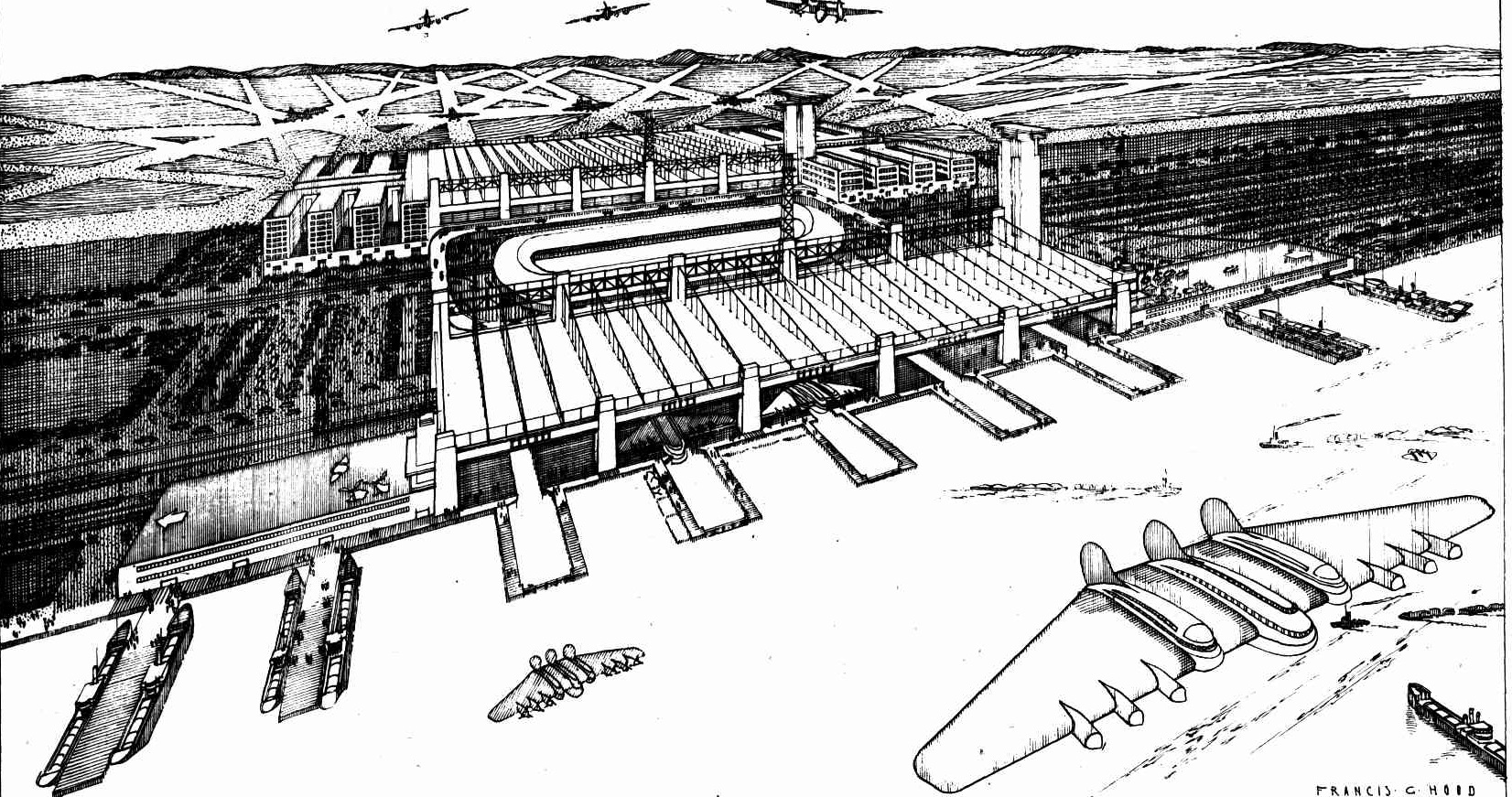
AERIAL VIEW.
THE AIRPORT OF TO-MORROW (1945, February 7). Construction (Sydney, NSW : 1938 - 1954), p. 10. Retrieved from http://nla.gov.au/nla.news-article223544443
THE AIRPORT OF TO-MORROW
AUSTRALIA'S INTERNATIONAL AIRPORT BASED AT NEWPORT, N.S.W.
From "The Australasian Engineer Year Book”
By Francis G. Hood, Architect, in association with Florence M. Taylor, Architect, and Charles O. Harrison, B.E.
An airport hotel, with ample lounge and dining room space, is easily reached by motor coach from either side of the airport. The circulatory road system also serves for mails and may likewise carry heavy vehicles transporting aircraft engines from the hangars to more distant workshops to undergo complete overhaul. Alternatively separate roadways, or railways served by gantries may be provided for this service. An important feature of Mr. Hood's design is the use of turntables for giant aircraft within the hangars where passengers, mails and goods are loaded or unloaded and top overhauls carried out between flights; these operations being assisted by portable platforms at the various levels which can be' swung aside to clear the aircraft. In the case of the seadrome, the flying boats are warped in through a lock to avoid changes in tidal level and are simply turned round as required in the circular basins within the hangars where the water level can be adjusted accurately to facilitate loading and unloading operations. Provision is made also for a dry dock for inspection of the hulls while in the hangars. Wide spans are called for at the hangars. In this case the necessary span is assumed to be 300feet. It is suggested that some type of suspended roof may be found practicable, though this is an independent structural problem. The roof, in any case, is designed on the louvred principle so that aircraft engines can be run in the hangar without causing undue wind disturbances.
Wharf facilities are also indicated on the plan adjacent to the seadrome thus linking the airport directly with another major transport system. Administration offices and workshops are also provided tor and another necessary feature is a' bond store or stores. The workshops and stores are served by rail as well as by the circulating road system. In this as well as in the other features, the airport design shows considerable flexibility. Although drawn to a scale the sizes of the various buddings and structures are based on assumed data and can be readily modified to meet the requirements of an . individual airport as regards capacity or natural physical features.
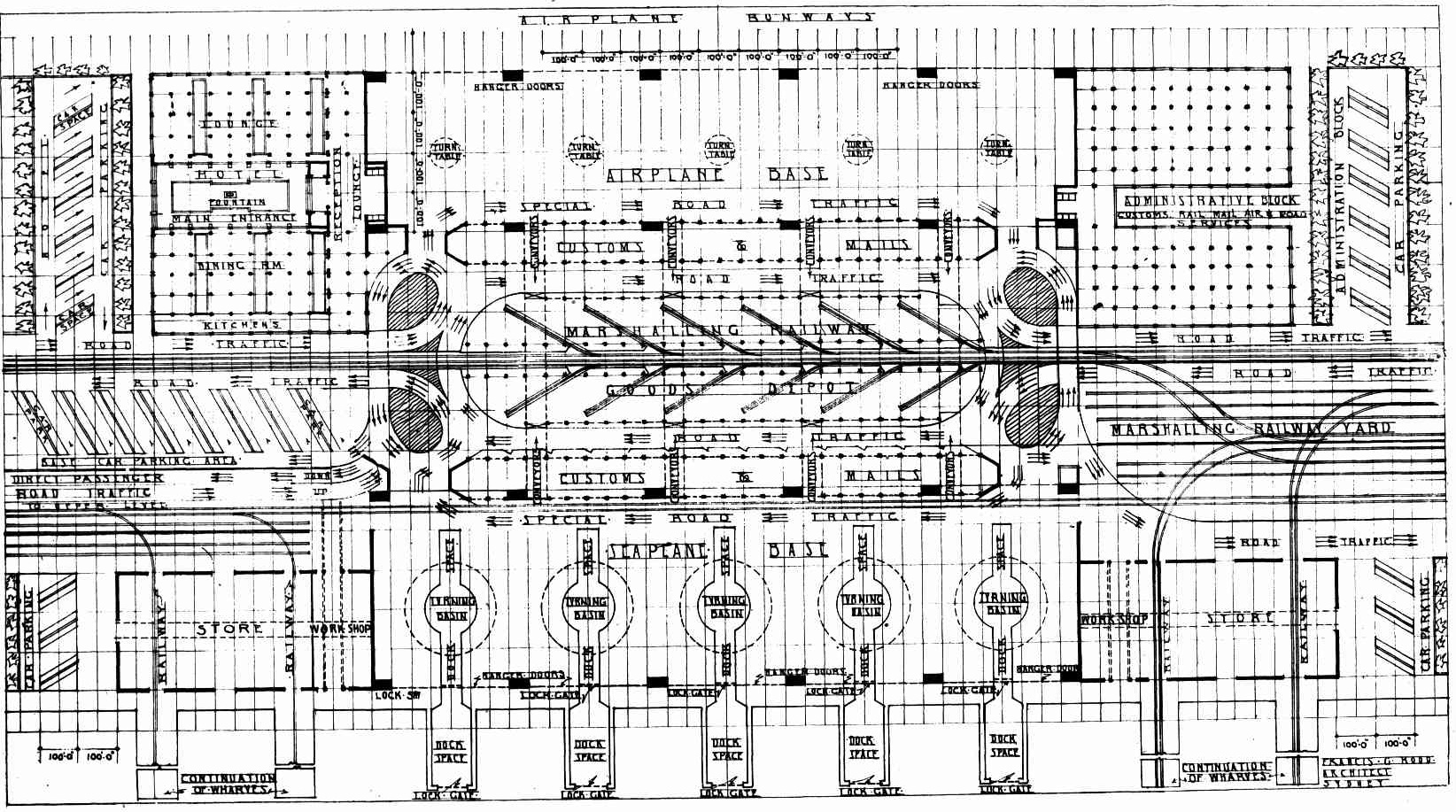
LAYOUT PLAN SHOWING BUILDINGS AND RAIL WAY, AIRWAY AND ROADWAY CIRCULATION.
THE AIRPORT OF TO-MORROW (1945, February 7). Construction (Sydney, NSW : 1938 - 1954), p. 9. Retrieved from http://nla.gov.au/nla.news-article223544444
ELEVATIONS AND SECTIONS FOR BUILDINGS FOR AN INTERNATIONAL AIRPORT.
Francis G. Hood, Architect, in association with Florence M. Taylor, Architect, and Charles O. Harrison, B.E.
In these elevations the aerodrome is on the left and the seadrome on the right. The hangar buildings have high louvred roofs with long clear spans to accommodate the largest aircraft. Subways connect the two sections of the airport and above these subways are the railway yards surrounded by a loop access road. The plan view shows also the hotel and administrative blocks. ELEVATIONS AND SECTIONS FOR BUILDINGS FOR AN INTERNATIONAL AIRPORT. (1945, February 7). Construction (Sydney, NSW : 1938 - 1954), p. 13. Retrieved from http://nla.gov.au/nla.news-article223544481
Rose Bay had already been chosen in 1937, originally as the destination for moving air mail. Six Short S23 'C' Class Empire flying boats were produced for Australia by Short Brothers at the Rochester Seaplane works in the UK and were named Coolangatta, Cooee, Carpentaria, Corio, Coogee and Coorong. The first full service with passengers from Sydney to Southampton departed on July 5th 1938, with the Empire Flying Boat and Air Mail Service Cooee flying a first-class service with 30 stops between Sydney and London, thereby creating the now famous 'kangaroo route'.
Hilda Hope McMaugh
On November 15, 1919, another Australian woman was gaining R.A.F. qualifications prior to heading home, Hilda Hope McMaugh. Hilda was a nurse who served with the Australian Army Nursing Service during World War I. She took a pilot's licence in England in 1919, and her achievement was recorded on film, but Hilda was not allowed to use her licence within Australia, it would seem due to her gender. Women were not allowed to be instructed in pilot training until after July 1926.
AUSTRALIA'S FIRST WOMAN AIR PILOT.
("Times.") LONDON, Sunday.
Nurse MacNaugh, an Australian, the first woman to pass the flying tests since the war, completed the course for the R.A.F. pilot certificate to-day. She leaves for Australia on Monday with the intention of partaking in commercial aviations. AUSTRALIA’S FIRST WOMAN. (1919, November 19 - Wednesday). Toowoomba Chronicle (Qld. : 1917 - 1922), p. 5. Retrieved from http://nla.gov.au/nla.news-article253022914
Hilda went on to establish a private hospital, St Elmo's Private Hospital at Uralla in 1923, working there until she retired in 1950, the hospital being 'retired' with her.
The Armidale Express reported on February 23, 1923:
"General Cox said it gave him great pleasure to come to Uralla that day to open this hospital.
"He had known Sister McMaugh on active service, and considered there was no woman in Australia better fitted to take charge.
"She was well thought of by both officers and soldiers on active service, and stood high in the estimation of the Army doctors." NEW HOSPITAL AT URALLA (1923, February 23). The Armidale Express and New England General Advertiser (NSW : 1856 - 1861; 1863 - 1889; 1891 - 1954), p. 10. Retrieved from http://nla.gov.au/nla.news-article193673016
St. Elmo Hospital.
St Elmo Private Hospital has proved a boon to the community since being established several years ago by Sister McMaugh, under whose management it has progressed rapidly. Favorably situated, it commands a view of the town. Since acquiring the property, Sister Mc Maugh has made great improvements to the building and ground. An isolation ward is a recent addition, also a tennis court, and the grounds have been further beautified with flowers. There is a nursing staff of six, including an obstetric nurse. Surgical, medical, and lying-in cases are treated. St. Elmo Hospital. (1929, October 28). The Uralla Times (NSW : 1923 - 1954), p. 1. Retrieved from http://nla.gov.au/nla.news-article176735779
MATRON MCMAUGH OR URALLA HOSPITAL TO RETIRE
After 26 years as matron-owner of the St. Elmo Private Hospital, Matron H. H. McMaugh intends to retire. She will live in Armidale with her sister, Miss E. C. McMaugh, of Brown Street.
The hospital, which has been bought by Mr. W. L. Colen, of Sydney and Mr. Ted Spensley, of Armidale, will be converted into a private hotel.
Commenting this morning Mr. Spensley said the hospital would be converted into a high class private hotel.
"It will be used as a recreation- centre for visitors from Armidale and Tamworth.
"The hotel has its own baths and tennis courts. They are set in spacious well kept gardens.
"We have already applied for a liquor licence, and renovations are under way.
"It is one of the nicest spots in New England. There are very few places in Armidale to equal it.
CATER FOR TRAVELLERS
"Travellers will be able to go to the hotel for afternoon tea and a game of tennis, or a swim any afternoon.
"We want to take the overflow of Armidale tourists.
"Trained nurses will care for visitors' children.
OPEN NOVEMBER 15
'The opening of the hotel on November 15, will be widely publicised.
"My partner, Mr. Colen, who will manage the hotel, was the manager of a large firm in Holland.
"We have a Dutch chef.
"In the grounds of the hotel we intend putting tables, covered by colourful beach umbrellas.
NEW HOSPITAL
" I feel that the closing of the hospital will give the Uralla people a better chance of getting a new public hospital.
"I will do all I can to help in this regard," he said.
"The baths will still be been to the Uralla public, continued Mr. Spensley.
During the season we intend to stage carnivals with Armidale swimming club.
"We will be holding an official opening," he concluded. MATRON McMAUGH OF URALLA HOSPITAL TO RETIRE (1950, October 2). The Armidale Express and New England General Advertiser (NSW : 1856 - 1861; 1863 - 1889; 1891 - 1954), p. 6. Retrieved from http://nla.gov.au/nla.news-article194197383
Reports from a 1952 court case indicate Mr. Spensley sold Hilda worthless shares, which the judge hearing the case dismissed, finding her unimpressive as a witnnes "I believe Spensley's story as to the incidents leading up to the sale of the shares, and I do not believe Matron Mc-Maugh's story," His Honour declared.
"I was not satisfied with either the plaintiff or the defendant as witnesses. The plaintiff was a very unimpressive witness — in fact, I have rarely seen a more unimpressive plaintiff in a case involving such a substantial claim. ''. COMPANY MANAGER EXONERATED OF FRAUD (1952, June 19). The Uralla Times (NSW : 1923 - 1954), p. 6. Retrieved from http://nla.gov.au/nla.news-article175991938
Born Caroline Hilda Hope On March 11th 1885 at Kempsey, Macleay River, NSW, 'Hilda' was the second daughter of George McMAUGH and Clementina Sarah (Daisy) nee KER who married in Kempsey in 1882. George died of heart failure at his home in Armidale on February 13th, 1932; Daisy died in August 1938. Her sister was Ella Campbell (Pat) b.1883 – d.13/5/1970 Uralla, NSW, their address, “Torrington”, Armidale.
Hilda passed away in 1981, leaving money to the Uralla community for the creation of services for the elderly, leading to the creation of McMaugh Gardens Retirement Home. It is her adventure to become a pilot that she may want to be remember for though, with this report on her return home lending insight:
A WOMAN AVIATOR.
TEST FLIGHT IN A GALE. HOW MISS McMAUGH WON HER TICKET.
"A young lady from Armidale, Miss. H. McMaugh, was announced to try for her ticket as an aviator last Saturday," writes a London correspondent, under date November 25. ''That meant for me a rushing trip to Northolt Aerodrome, not far from Harrow on the Hill, and there I was fortunate in meeting the lady herself just after she had accomplished her ambition. It was a wild nasty day, and I never expected her to make the final fly the last stage of the trial, and unaccompanied. It had taken altogether about five hours, and this was the finish. But she went gliding up alone as easily as a bird, did the figure 8, didn't care a rap for the weather, and descended a winner in the midst of a shower of congratulatory cheers from her fellow-students — all men except her.
The school is located in a very bleak paddock, but Miss McMaugh is a lively, breezy girl, who puts a new tinge on gloomy surroundings. She is a true specimen of the frank-faced athletic Australian girl, as full of life as a New England rock wallaby, with a bright, good-looking face, lithe form, and a very good-tempered laugh. She is fond of most forms of sport. Her people all live in the placid city of the northern tableland, and knew nothing of her recent ventures.
Flying is not the only one. She took it into her head to qualify as a motorist, and has already received the certificate of the Royal Automobile Club, the test having been in Piccadilly Circus of all places, and during the traffic turmoil of the recent railway strike. At home she would never drive the car, and she said to me with a laugh: "I don't know what dad will think of all this when he hears of it."'
Miss McMaugh served as a nurse in Egypt, and when the armistice came along she and three other nurses had a brief holiday in the Holy Land, enjoying it very much. They wore in Jerusalem, of course, and many other Scriptural places, but one day they all went for a ride on Australian horses. Miss McMaugh's mount, a big startled by a nigger's gharri, cleared off down Bethlehem Hill, a real runaway for nearly a mile. "But I didn't fall off," and she laughed at the memory. The little party visited several Italian cities, and those on the Rhine, and also the special battlefields of France and Belgium.
HER RETURN HOME.
In connection with her return to Australia the Tamworth "Observer" of Wednesday has the following: —
" By yesterday morning's (Tuesday) Glen Innes mail there passed through Tamworth on her way home to Armidale, Flight-Lieut. (Sister) H. McMaugh, who holds the great distinction of having been the first Australian woman to fly, and to thus receive the Flying Pilot's Certificate.
Four years have passed, since Sister McMaugh finished her training at Tamworth District Hospital, and left on active service. The lady lieutenant returned by the Aeneas, and looks well. She has passed through many interesting experiences. She was especially pleased with the climate of Egypt, where she met another ex-sister of the hospital in the person of Sister Doohan, also there on active service. The train was met by the Mayor (Aid. Bourne), Dr. Buckley and Matron Moffit, with Sisters Palmer and Denneen of the Tamworth District Hospital, whose president (Ald. Wane) arrived later and also Rev. Father Mullins. All present joined in congratulating Sister McMaugh on her safe return to Australia and home." A WOMAN AVIATOR. (1920, January 28). Daily Examiner (Grafton, NSW : 1915 - 1954), p. 2. Retrieved from http://nla.gov.au/nla.news-article195359204
Another, which includes some early women being passengers in South Australia:
Sister McMaugh.
So, Sister Hilda McMaugh commands an Instant admiration for her sportsmanlike attitude. While the war called her she gave her professional services as a nurse, and put in three strenuous years in Egypt with the A.I.F. The men worshipped her, for she was a tower of strength in combating every form of sickness and disease, and was always womanly, thoughtful, and understanding. Now Sister McMaugh is illustrating the dual possibilities of womanhood, for she has speedily qualified as a pilot. To be the first Australian Woman to fly is a record of which to be lastly proud, and we all share in this reflected glory. It was an unusual and intrepid exploit. The war was over, and the nurse suddenly resolved to learn to fly. She said, smilingly, to a questioner, that she had nearly done it involuntarily several times amid war perils, so she might as well make a free choice now. To think was to act, and in November, a month after the great decision, Sister McMaugh had her "Wings." Capt. Sykes, her instructor, gave her five hours in the air and many hours of schooling on land, and then she had achieved her ambition. She has also ''looped the loop" and done other stunts. She is 28 years of age, is tall, and good looking, and will doubtless receive a tremendous ovation now that she is coming among home as the latest specimen of "Australian bird."
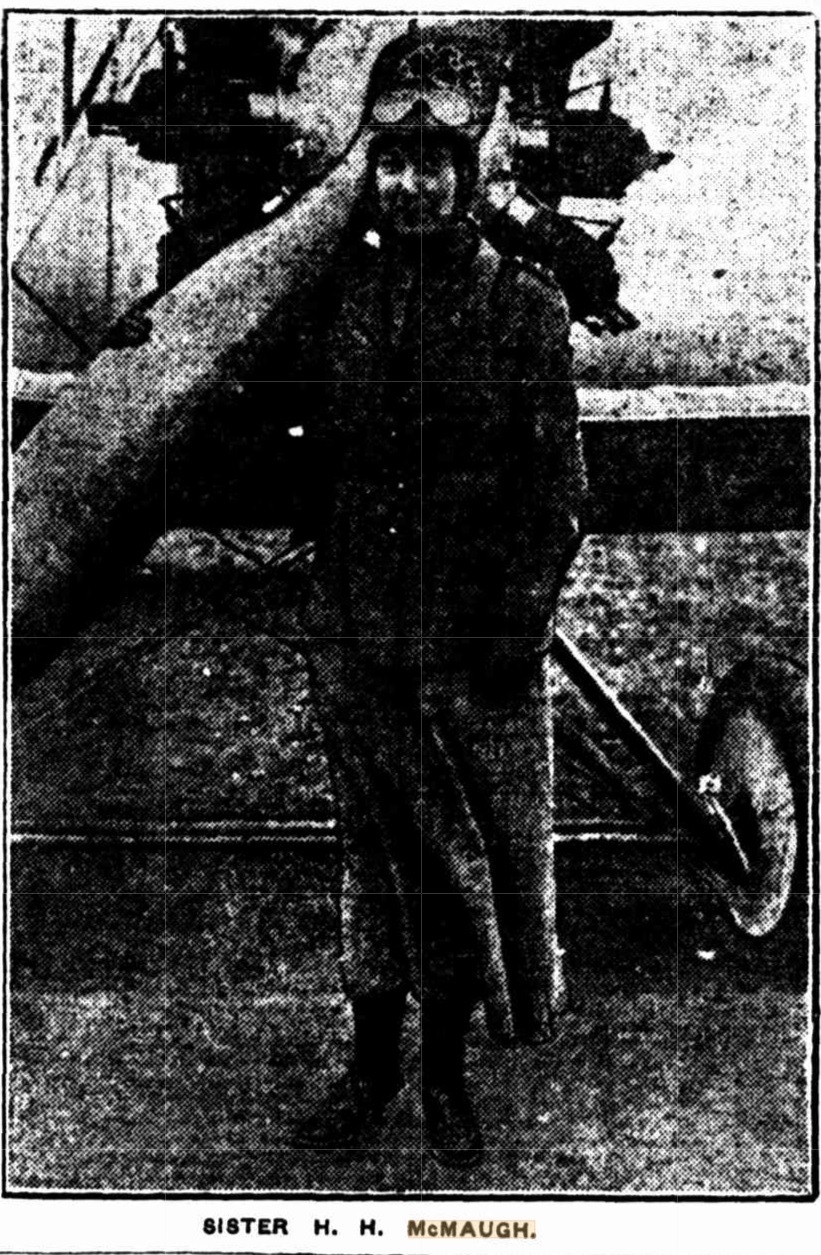
Lady Mayoress as an Aviator.
Our Lady Mayoress possesses any amount of initiative and courage; the former was demonstrated at the New Year'a Eve celebration and the latter on Wednesday of this week. Wednesdays are evidently Lady Hacketts special observances. We know all about the other Wednesday; now for the succeeding one. It seems that our Lady Mayoress had consented to make a flight over Adelaide with Capt. J. R. Moore, A.F.C- In his Sopworth-Dove aeroplane, and in transit (literally so!) to drop a letter into The Register Office, conveying new year greetings to the good folk of the city and suburbs. The flight began all right from Glenelg, but a minor portion of the mechanism played up, and a special landing had to be made. So ended flight No.- 1. But Lady Hackett refused to thus abandon the trip, and in the afternoon again "mounted the clouds" with Capt. Moore. This time a deserved success was achieved, and "'Ladies' Aviation Day" in local history will chronicle the intrepidity of our first "flying Mayoress." Others who successfully essayed a first air ride - were Mrs. Angus Johnson and Miss Ethelwyn Robin. WOMEN'S SPHERE (1920, January 17). Observer (Adelaide, SA : 1905 - 1931), p. 40. Retrieved from http://nla.gov.au/nla.news-article165674366
There is no memorial anywhere to this lady.
Australian Pilots' Licences for Australian Women
It would be another 7 years before an Australian woman was named as, officially, an Australian pilot. Women were allowed to learn to fly from 1926:
AVIATION FOR WOMEN
MELBOURNE. Wednesday
Civil aviation courses for women will he conducted by the Australian Aero Club, subsidised by the Government, beginning next month, and the club has decided not to confine instruction to men. Women desirous of becoming pilots will be given the necessary tuition. AVIATION FOR WOMEN (1926, July 22). The Labor Daily (Sydney, NSW : 1924 - 1938), p. 1. Retrieved from http://nla.gov.au/nla.news-article239801699
Millicent Maude Bryant (née Harvey, 8 January 1878 – 3 November 1927) was one of ten children of Edmund George Harvey and Georgiana Sarah Bartlett Harvey and born at at Apsley, Wellington, New South Wales. Her family, the Harveys, moved to Manly for a period after her younger brother, George, contracted polio (one of the then treatments was “sea-bathing”). She met and married a public servant 15 years her senior, Edward Bryant in 1900. Edward was the son of then Manly residents John Ambrose and Caroline Bryant, and a brother of Artist Charles David Jones Bryant. They had three children but the couple separated not long before Edward died on February 15th, 1926.
BRYANT—HARVEY.—May 9, at Pomona, Wellington, N.S.W., by the Rev. E. Barry-Brown, E.D., Edward James Bryant to Millicent Maude Harvey. Family Notices (1900, June 16). The Sydney Mail and New South Wales Advertiser (NSW : 1871 - 1912), p. 1438. Retrieved from http://nla.gov.au/nla.news-article165298150
BRYANT.-February 15, at a private hospital. North Sydney, Edward James, assistant manager Electric telegraph Department, second son of late J. A. and Caroline Bryant, Hirondelle, Manly. Family Notices (1926, February 17). The Sydney Morning Herald (NSW : 1842 - 1954), p. 14. Retrieved from http://nla.gov.au/nla.news-article16278589
Later that same year Millicent commenced instruction with the Australian Aero Club at Mascot in Sydney, accepted by the Aero Club’s chief instructor, Captain Edward Leggatt (himself a noted First World War fighter pilot), soon after the club had opened tuition to women.
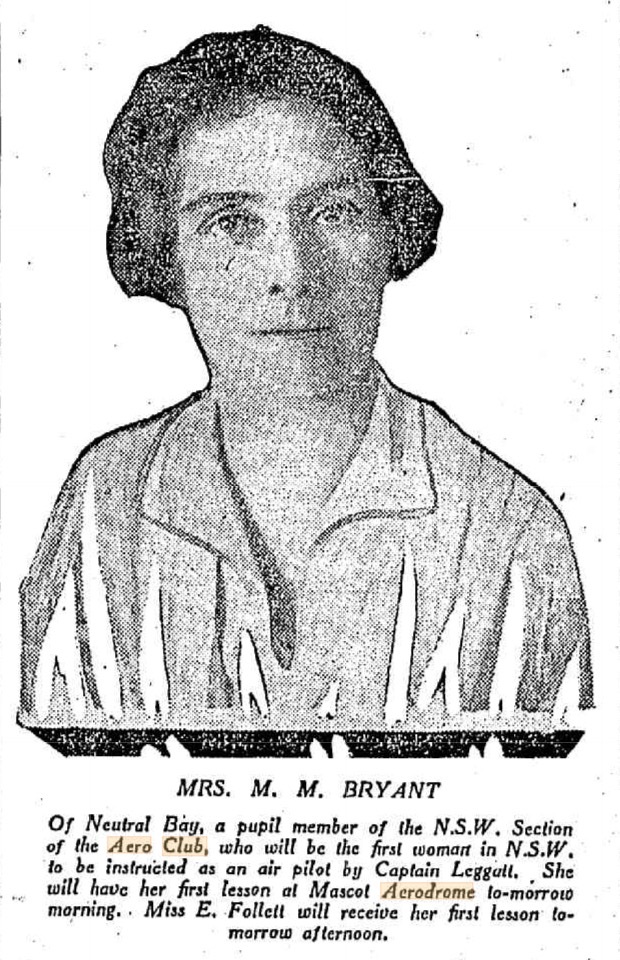
Society (1926, November 14). The Sun (Sydney, NSW : 1910 - 1954), p. 37. Retrieved from http://nla.gov.au/nla.news-article224126139
Millicent made her first solo flight in February, 1927. Newspapers all around Australia were following her story, and in late March she took the test for the “A” licence that would enable her to independently fly De Havilland Moth biplanes.
FIRST WOMAN AIR PILOT
Sydney has Australia's first qualified woman air pilot - Mrs Bryant of Neutral Bay. Word came from Melbourne last week that she had successfully passed the examination conducted at Mascot by Captain Follit, of the Civil Aviation Department. FIRST WOMAN AIR PILOT. (1927, April 6). Tweed Daily (Murwillumbah, NSW : 1914 - 1949), p. 4. Retrieved from http://nla.gov.au/nla.news-article190195005
Mrs. Bryant began training for a licence to carry passengers and flew regularly in the months that followed. Tragically she stepped onto the Sydney ferry Greycliffe on its regular 4.14pm run to Watson’s Bay on November 3, 1927 and less than an hour later was among 40 dead after the ferry was cut in half off Bradley’s Head by the mail steamer Tahiti. She was 49 years of age.
Her funeral at Manly two days later was attended by hundreds of people and accorded a remarkable aerial tribute:
Late Mrs. M. M. Bryant.
WREATH FROM THE AIR
A striking tribute was paid to Mrs. Millicent Maud Bryant (the first woman in Australia to gain a pilot's license from the Aero Club), who was buried in the Church of England Cemetery, Manly on Saturday afternoon. Five aeroplanes from the Mascot aerodrome flew over the procession as it wended its way to the cemetery. As the burial service was read by the Rev. A. R. Ebbs, rector of St. Matthew's, Manly, one of the planes descended to within about 150 feet of the grave, and there was dropped from it a wreath of red carnations and blue delphiniums.
The wreath fell within 50 yards of the grave, and attached to the floral tribute was a card bearing the following inscription : —
"5th November, 1927. With the deepest sympathy of the committee and members of the Australian Aero Club—N.S.W. section."
The airmen who flew over the cemetery were Captain E. W. Leggatt and Captain R. M. King (in Aero Club's machines) and Messrs S. Tyler, H. W. Ross, T. O'Dea, and H. Drummond. The chief mourners were Messrs Bowen Bryant (son), E. G. Harvey, (father), and. F. H. Harvey and G. S. Harvey (brothers). The Aero Club was represented by Messrs. Geoffrey Hughes (president), R. H. Mitchell, L. L. Nall, Milton Kent, and W. J. Kingham, and the Department of Civil Aviation was represented by Mr. C. Crateau. Late Mrs. M. M. Bryant. (1927, November 10). Wellington Times (NSW : 1899 - 1954), p. 13. Retrieved from http://nla.gov.au/nla.news-article143262879
Five aeroplanes flew over Manly cemetery during the burial of Mrs. Millicent Bryant, one of the first women members of the Aero Club. A wreath from a 'plane piloted by Captain E. W. Leggatt dropped near the grave. It was composed of red carnations and blue delphiniums, the club colors. The 'planes circled round and round during the service, and then, just as the Rev. A. R. Ebbs raised his hand in the concluding words one detached itself from the others and flew low over the grave. It rose, and the five departed.
Mr. Bowen Bryant was the only one of Mrs. Bryant's three sons who could be present. Mr. George Bryant, who was married on October 27, could not arrive from Tasmania in time, and Mr. John Bryant, who has been in England, is expected to arrive in Sydney at the end of this month.
Among the mourners were Mrs. Bryant's father, Mr. E. G. Harvey, of Kanimbla Valley; her brothers, Messrs. F. H. Harvey, M. Harvey, and G. S. Harvey; her cousin, the Surveyor-General, Mr. H. B. Matthews, and Mrs. S. Harvey. JOURNEY'S END (1927, November 6). The Sun (Sydney, NSW : 1910 - 1954), p. 5. Retrieved from http://nla.gov.au/nla.news-article222736461
In 2006 a new memorial to Millicent Bryant was placed in Manly Cemetery. It was dedicated by the late Nancy Bird Walton. Gaby Kennard, the first Australian woman to fly a single-engine plane around the world, also attended the ceremony.
A day after Millicent took her examination, another young woman took to the skies for a solo flight and by July had her pilot's licence:
SECOND WOMAN FLIER
Another Sydney woman will soon be a full-fledged pilot. Miss E. M. Follett, a pupil of the Australian Aero Club, successfully accomplished her first solo flight to-day. She is the second the distinction. SECOND WOMAN FLIER (1927, April 7). Evening News (Sydney, NSW : 1869 - 1931), p. 13. Retrieved from http://nla.gov.au/nla.news-article129074151
Evelyn Follett, born in Marrickville, New South Wales, became the fourth Australian woman to earn a pilot's licence. A tiny woman, she had to sit on a cushion to reach the controls. She went on to set up an airways administration company, Adastra with her brother Captain Follett and Captain Bunny Hammond. Adastra also offered a flight school in Bega, New South Wales, and would conduct aerial survey services for geophysical study.
Aero Club Pupils Pass Test
Three more pupils have gained their pilot licenses at the Aero Club. They are Mr. L. L. Nail, of Longueville; Mr. W. Y. Hunt, of Kogarah;' and Miss E. M. Follett, of Darling Point. Miss Follett is-the second lady in . Australasia to gain the license, the first being Mrs. Bryant. The three pupils mentioned make 25 for the year, which is a record for a first year in such a club. Aero Club Pupils Pass Test (1927, July 12). The Daily Telegraph (Sydney, NSW : 1883 - 1930), p. 25. Retrieved from http://nla.gov.au/nla.news-article246984477
Later that same year another lady had her pilot's licence and by the Autumn of 1928 the first women's only aerial race 'The Oaks' was held at Mascot:
Another Woman Pilot
Mrs. M. C. Upfold, of Kirribilli, a pupil member of the Australian Aero Club, obtained her A grade pilot's license yesterday. She was tutored by Captain Leggatt, M.C., chief instructor. Mrs. Upfold, who makes the 38th pilot to qualify with the Aero Club in New South Wales, left for a visit to the Queensland Aero Club immediately after passing her flying test. Another Woman Pilot (1927, December 24). The Daily Telegraph (Sydney, NSW : 1883 - 1930), p. 36. Retrieved from http://nla.gov.au/nla.news-article246210320
Wins the Oaks
BLACKHEATH'S LADY PILOT
Miss Meg. Reardon brought honor and glory to Blackheath when she carried off The Oaks, at the Aerial Pageant, held at Mascot Aerodrome, on Saturday. The race is for women pilots, trained by the Club, and Saturday's was the first race of the kind in Australia, There were three starters In the event, the winner taking the prize from Mrs. A. M. Upfold and Miss M. Follett, The distance was 10 1/2 miles and the time 9 minutes, 48 secs. The average speed was 66 miles per hour. Miss Reardon is a daughter of Mr. and Mrs. A. Reardon, well-known residents of Blackheath, This paper joins in the hearty congratulations extended to the plucky young lady. Wins the Oaks (1928, April 3). The Blue Mountain Echo (NSW : 1909 - 1928), p. 4. Retrieved from http://nla.gov.au/nla.news-article108951729
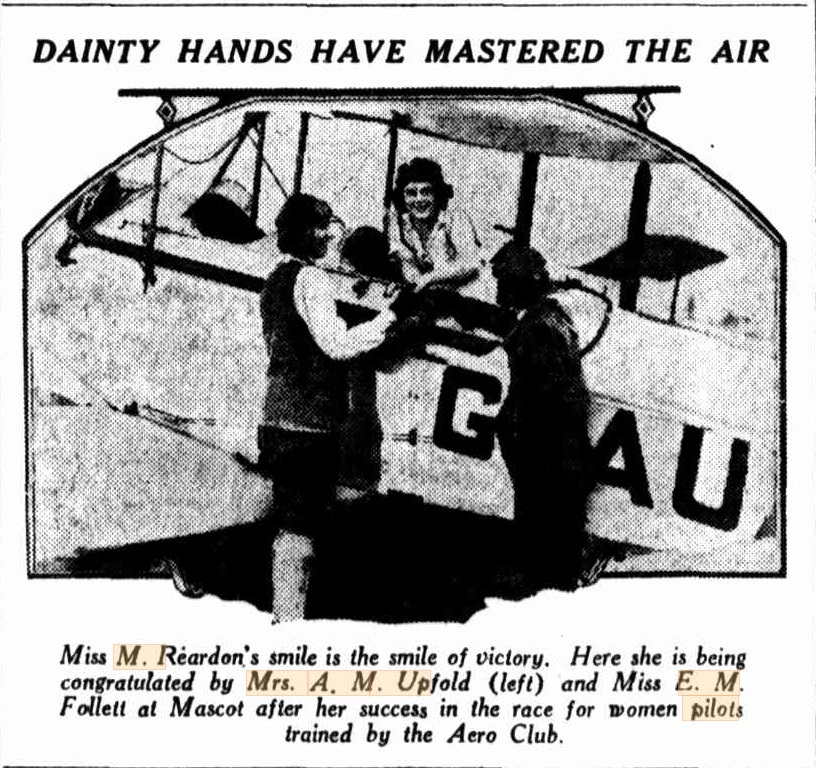
DAINTY HANDS HAVE MASTERED THE AIR (1928, April 1). The Sun (Sydney, NSW : 1910 - 1954), p. 2. Retrieved from http://nla.gov.au/nla.news-article222012775
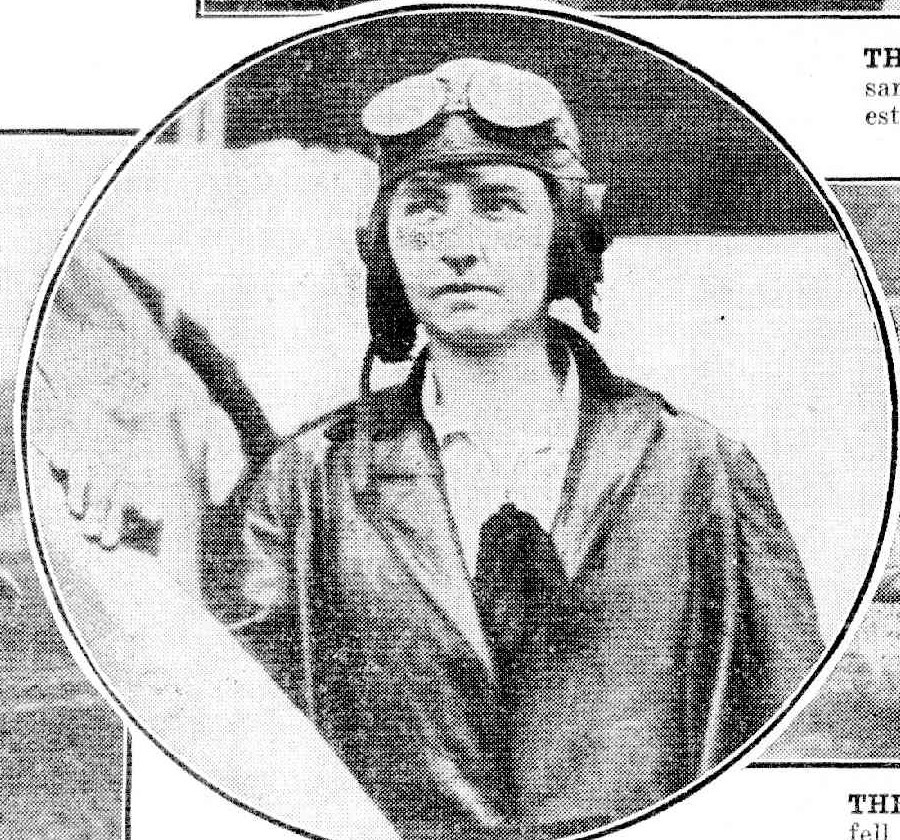
MRS. UPFOLD, pilot, before flying to Brisbane yesterday for the air pageant. THE NIAGARA TAKES STATE GOVERNOR HOMEWARD ON FURLOUGH (1928, August 24). The Daily Telegraph (Sydney, NSW : 1883 - 1930), p. 21. Retrieved from http://nla.gov.au/nla.news-article246812070
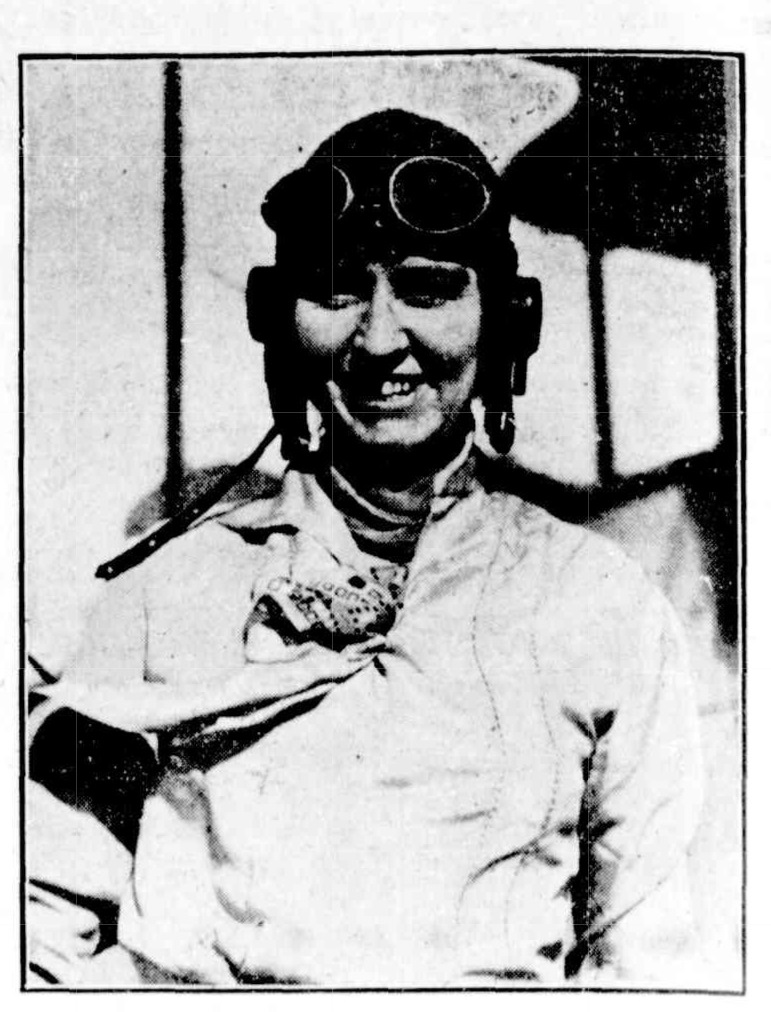
MRS. A. M. UPFOLD, an intrepid lady aviator from New South Wales, who thrilled the spectators with her skilful aerobatics at the Air Pageant on Saturday. No title (1928, August 27). The Brisbane Courier (Qld. : 1864 - 1933), p. 16. Retrieved from http://nla.gov.au/nla.news-article21321337
Alice Marion 'Chippy' Upfold (born 1900) was a widow by the time all these 'stunts' were being performed. Her husband, Charles Edward Upfold (born 1880), died in Brisbane in June 1926 - they had only been married a few years:
MARRIAGE. UPFOLD — BARNARD.—On the 2nd August, at St. Andrew's Church, Lieutenant C. E. Upfold, youngest son of the late E. Upfold, Esq., Sydney, to Alice Marion, eldest daughter of Mr. and Mrs. H. G. Barnard, Rio Station, Edungalba. Family Notices (1921, August 3). Morning Bulletin (Rockhampton, Qld. : 1878 - 1954), p. 1. Retrieved from http://nla.gov.au/nla.news-article53981438
Her husband was a son of Charles Upfold (15 December 1834 – 14 March 1919), an English soap manufacturer of great prominence in Australia, and Sarah Ann Temperance Blundell. Charles senr. was also a Director of Aberdare Collieries Co. Ltd., and the Chairman of the board of management for its railways. He eventually controlled the colony's largest soap industry – The Sydney Soap and Candle Company, registered 25 July 1885. As the name implies, the registered office, along with a smaller factory at Botany, was at Sydney, the capital city of the colony, but the biggest works were at Tighes Hill, Newcastle. Probably their most famous product, one which stood the test of time, was Siren soap, which was later renamed Velvet. It was still being marketed in N.S.W., by Unilever, who acquired the company after his death, in the latter part of the 20th century. Many argued that it was superior to Lever Bros famous Sunlight soap.
Alice Upfold would remarry in Sydney in 1939, this time to someone her own age, and another Upfold, John (Jack) Kingham Upfold, who had been born in England in 1900. Prior to that:
FEMINIST CLUB.
The weekly "at home" of Feminist Club members took place at the club yesterday afternoon, when live speakers were entertained. Three lady pilots from the New South Wales Aero Club, Miss Margaret Reardon, Miss E. Follett, and Mrs. A. M. Upfold, spoke on "Aviation from a Woman's Point or View."
Mrs. Adela Pankhurst Walsh, the organiser for Australia of the Industrial Peace Union, gave an address on industrial peace and the aims of the union. Miss Lilian Fowler, the first woman alderman of Sydney, who was the guest of honour, outlined the methods of her campaign, and spoke of the work which she hoped to do. Mrs. Liddell, a foundation member of the club, who was to have been the other guest of honour, was unable to be present, but a vote of congratulation on her recent appointment to the Film Censorship Appeal Board was passed.
Mrs. Kenneth Street presided, and the hostesses were Mrs. H. Priestley, Mrs. A. H. Sherwood, and Mrs. W. Skinner.
Those present included Mrs. Albert Littlejohn, Mrs. S. E. Vickery, Mrs. C. A. Fraser, Mrs. P. A. Cameron, Mrs. C. F. Anderson, Mrs. A. Tates, Mr3. C. Holburn, Mrs. A. Wyatt, Mrs. H. Peek, Mrs. E. H. Meade, Mrs. G. Smith, Mrs. George Perrins, Mrs. A. G. Norman, Mrs. A. N. White, Mrs. R. Davis (London), Miss O. Solomon, Miss Butler, Miss J. Crain, Miss E. Jeffries. Mrs. E. M. Bradbury, Mrs. E. Shaw, Mrs. C. Hyland, Mrs. E. Proud, Miss E. Smith, and Miss G. Meade. FEMINIST CLUB. (1928, December 12). The Sydney Morning Herald (NSW : 1842 - 1954), p. 8. Retrieved from http://nla.gov.au/nla.news-article16515975
These women are included not only because they earned the first pilot's licences for women in NSW but also because they met another well-known aviatrix over Long Reef on her way to Sydney:
WAITING HER ARRIVAL
Sydney Women Rally Round Amy
"Miss Johnson is coming through in the pluckiest way, and it is fitting that the first great effort to welcome her should be made by women citizens."
MISS PRESTON STANLEY ex-pressed this opinion at a meeting at the Sydney Town Hall yester-day, held to arrange a public luncheon to Miss Amy Johnson, who is flying from England to Australia. Mrs. John Garlick convened the meeting, on the suggestion of Miss June Holland, who wrote to say that she thought all women should show their appreciation of the epoch-making flight
THE COMMITTEE
Mrs. Garlick presided, and the following committee was elected: — President, Mrs. John Garlick; Miss June Holland and Miss Margaret Chalmers (Forum Club), secretaries; Dr. Lucy Gullett (treasurer).
An executive of seven was appointed, including Mrs. Albert Littlejohn (United Associations), Miss S Williams (Women's College), Mrs. Florence Taylor (Arts Club), Miss Janet Mitchell (Thrift Service), Miss M. M Mackay (Queen's Club), and Mrs. Alfred Lee (Red Cross). It was decided to hold the lunch-eon as soon as possible after Miss Johnson's arrival. It is to be called "the Women Citizens' Public Luncheon," and is to be held in the Sydney Town Hall. The price of the tickets was fixed at 5/, and are to be avail-able at the Town Hall and Paling's.
INTERESTED WOMEN
Others who attended were: — Lady Murdoch, Mrs A. V. Roberts, Mrs. E. M. Griffiths (Women Justices), Miss Norris (ex-Service Women's Club and Victoria League), Miss McKiuuop (Catholic Women's Association), Mrs. Malley Soldiers' Mothers, Wives, and Relatives' Victory Association), Mrs. J. Hayden, Mrs. J. Horne, Miss C. McGauly, Miss Clutterbuck, Mrs. Garton, Mrs. Johnson-Mulholland, and Miss Valmai Jenkins. WAITING HER ARRIVAL (1930, May 17). Daily Pictorial (Sydney, NSW : 1930 - 1931), p. 21. Retrieved from http://nla.gov.au/nla.news-article246178095

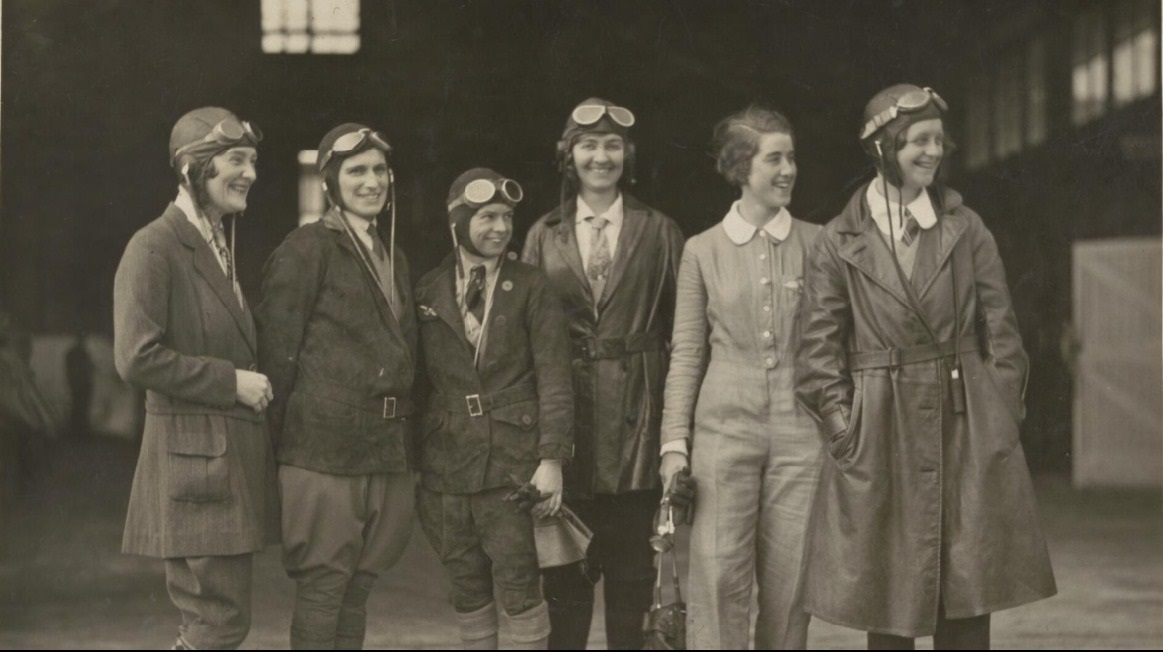
The six women pilots who provided an aerial escort for British aviator Amy Johnson when she arrived in Sydney on June 4th 1930. Amy was the first woman to fly on her own England to Australia and the names of the pilots who formed the escort. The pilots were from left to right: Margaret 'Meg' Skelton, Florence 'Bobby' Terry, Evelyn Follett, Alice Marion Upfold, Phyllis Arnott and Freda Deaton. The photograph may have been taken outside a hangar at the Mascot aerodrome in Sydney. courtesy of National Library of Australia, National Library of Australia number nla.pic-an24664499 - (1930). Escort for Amy Johnson's landing in Sydney, June 4th, 1930 Retrieved from http://nla.gov.au/nla.obj-136823774
Amy Johnson CBE (July 1, 1903 – January 5, 1941) was a pioneering English pilot who was the first woman to fly solo from London to Australia. Amy obtained the funds for her first aircraft from her father, who was always one of her strongest supporters, and Lord Wakefield. She purchased a secondhand de Havilland DH.60 Gipsy Moth G-AAAH and named it Jason after her father's business trade mark.
Johnson achieved worldwide recognition when, in 1930, she became the first woman to fly solo from England to Australia. Flying G-AAAH Jason, she left Croydon Airport, Surrey, on May 5th and landed at Darwin, Northern Territory on May 24th, 11,000 miles (18,000 km). Six days later she damaged her aircraft while landing downwind at Brisbane airport and flew to Sydney with Captain Frank Follett while her plane was repaired. Jason was later flown to Mascot, Sydney, by Captain Lester Brain.
She received the Harmon Trophy as well as a CBE in George V's 1930 Birthday Honours in recognition of this achievement, and was also honoured with the No. 1 civil pilot's licence under Australia's 1921 Air Navigation Regulations.
AMY JOHNSON.
DUE AT SYDNEY THIS AFTERNOON.
Arrangements for Reception.
AT MASCOT 3 P.M.
Last night arrangements were completed for the reception of Miss Amy Johnson at the Mascot Aerodrome this afternoon.
The Fokker monoplane of the Australian National Airways, Limited, in which she will travel from Brisbane, is due to arrive at 3 p.m. The Jason Moth aeroplane, in which the flight was made from London to Brisbane, will be piloted by Captain Brain, of Q.A.N.T.A.S., who will land a few minutes before Miss Johnson. The Jason will be drawn up alongside the reception dais.
The Aero Club will send six aeroplanes, in charge of women pilots, to escort Miss Johnson to Mascot. These machines will be over Long Reef about 2 p.m., and will form two separate formations during the flight to the aerodrome. The pilots will be Mesdames Terry and Upfold, and the Misses Arnott, Deaton, Skelton, and Follett.
Miss Johnson will go from the aerodrome to Government House. She will be the guest of the Governor and Lady Game during her stay in Sydney.
The latest details respecting the flight from Brisbane and of the landing will be broadcast from 2FC, 2BL, 2UW, and 2GB. and from amplifiers around the aerodrome.
PRECAUTIONARY MEASURES.
A record crowd is expected to witness Miss Johnson's arrival, and elaborate arrangements have been made to ensure effective control of traffic.
The public will be directed to a specially barricaded area, and only those possessing special passes will be admitted by the police into the landing-ground.
This plan has been adopted as a safety measure for fliers and spectators alike, for should the crowd encroach on the landing area in Its present state it would be impossible for the large Fokker and the escorting planes to land with safety.
LARGE FORCE OF POLICE.
A force of 500 police, in charge of Super-intendents Leary and Linegar, will be on duty at the aerodrome.
"I am particularly anxious that the public should assist the police in every way." said the Commissioner of Police last night. "The landing-ground must be kept clear, and the public must remain behind the barriers. In this way everybody will be afforded an opportunity of witnessing the arrival of Miss Johnson. After the brief official welcome she will be driven slowly around the aerodrome, so that everybody may see her."
Police will be stationed at all approaches and motorists will be directed to parking areas.
AMBULANCES.
Two motor ambulances will be in attendance on the ground, and the ambulance-room at the entrance to the aerodrome will be fully staffed. An ambulance tent will be erected on the south-west side of the ground. Three other motor ambulances will be stationed at the South Sydney Ambulance Station, Botanyroad, and near General Holmes' Drive, over-looking the aerodrome. St. John's Ambulance Brigade has arranged for 50 men and women members to be present in uniform, and they will be located at various points around the aerodrome.
WEATHER FORECAST.
A special weather forecast for today was issued by the Acting State Meteorologist (Mr. Camm) last night. The weather should be chiefly fine, with some clouds. Cold, fresh, and squally, west to south-west winds are expected.
During the flight from Brisbane, fine weather should be experienced, and the visibility should be good. Winds should be fresh from the west, gradually increasing in velocity as the 'plane flies southward, and averaging about 30 miles an hour in New South Wales.
The "Southern Sun" with Miss Johnson aboard is expected to leave Brisbane about 9 a.m. to-day, and proceed to Sydney by the usual air mail route.
Spectators will recognise the Fokker by its Identification marking-VH-UNA.
THE WELCOME AT MASCOT.
On alighting, Miss Johnson will be conducted to a specially erected dais and listen to addresses of welcome, which will be broad-cast. Miss Johnson will be welcomed by the following:
Senator J. J. Daley (representing the Commonwealth Government), the State Attorney-General (Mr. Boyce), Chief City Commissioner (Mr. Garlick), Mr. Mutch, M.L.A., the Mayor of Mascot (Mr. Alexander), the president of the Aero Club (Captain G. F. Hughes), and the New Zealand Trade Commissioner (Mr. Schmitt). Miss Johnson will respond to the addresses of welcome. The proceedings on the dais will occupy about 15 minutes.
The aviatrix will be driven around the aerodrome so that everyone may obtain a good view of her, and will then depart for Government House. AMY JOHNSON. (1930, June 4). The Sydney Morning Herald (NSW : 1842 - 1954), p. 13. Retrieved from http://nla.gov.au/nla.news-article16705277
The girls had been practicing:
Fly in Formation
Mrs. John Terry, Miss F. Deaton, and Miss P. Arnott are three pioneer aviatrices in Australia. Their clever display of formation flying at the Ashfield Memorial service on Anzac Day has received the praise of men aviators, who know the difficulties faced in the turning and keeping the even space between each 'plane. Great credit is due to these three fearless women fliers,, all of whom haw their pilot licenses to carry passengers. Mrs. John Terry, of Elizabeth Bay, has now been flying for two years, and is one of the few women to proudly pass her acrobatics test. Commencing lessons in trick stunts, etc., at the end of last year, she speeded up her tuition, because of her departure from Sydney for a holiday, and went through her paces successfully in February.
ACROBATICS.
Miss Arnott and Miss Deaton, younger and less experienced fliers, are now preparing for their acrobatics also. At 8.30, usually find these three fearless women practising Wednesday and Saturday morning, at formation flying.
Miss Deaton usually takes the lead, though it is necessary for each to take her turn as leader. Starting in the formation of a V from the time they leave the ground, each aviutrix must fly wilh great care and steadiness, especially as the turns are taken. It is their ambition to fly in close formation, a difficult accomplishment, and to later cross over rom one position to tho other while flying.
RECOMMEND FLYING.
Each flier strongly recommends flying tor women, and is surprised that there ire so few who are attracted to this 'most thrilling of all sports.' Good eyesight, ii sense of balance, and strong heart is all the necessary qualifications one must have to learn to fly.
After the first two or three flights there is no sense of nervousness. In learning to pilot a 'plane your instructor has complete control of the duplicate joystick, and ono cannot come to any harm in learning. It is the first flight alone that challenges one's nerve, and after one successful flight there is no fear.
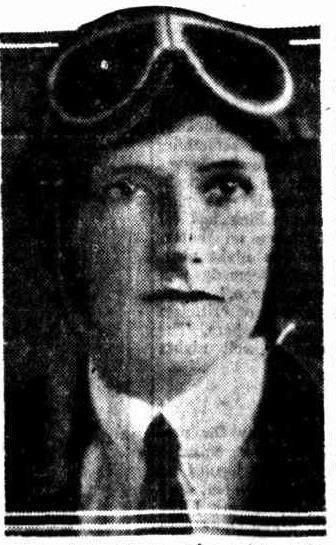
Mrs. John Terry, who, with Miss Aniott and Miss Deaton, flew in formation at the Ashfleld Anzac Service.
PIONEER AVIATRICES (1930, May 4). Sunday Times (Sydney, NSW : 1895 - 1930), p. 19. Retrieved from http://nla.gov.au/nla.news-article132063129
One of their Amy Johnson and formation 'crew' was Phyllis Arnott, of that biscuit family, who also came to Pittwater to be part of the Pittwater Regattas - and here another women's 'first' is recorded:
MISS PHYLLIS ARNOTT. COMMERCIAL PILOT.
Miss Phyllis Arnott has attained the distinction of being the first woman pilot in Australia to gain a B licence for commercial flying. She completed a cross-country flight from Sydney to Goulburn on Saturday on her final test for the licence. MISS PHYLLIS ARNOTT. (1931, February 24). The Sydney Morning Herald (NSW : 1842 - 1954), p. 5. Retrieved from http://nla.gov.au/nla.news-article16756791
Also at Pittwater during Regatta times, where aerial displays had been a offered since the 1930's:
At Pittwater
MRS. H. B. BONNEY, who flew from Brisbane to Melbourne in her plane, My Little Ship II during December, is now in Sydney, and will spend a week at the Hotel Australia before returning to Brisbane. Meanwhile she is for a few days one of a yachting party on Mr. E. R. Williams' yacht, Borough Belle, at Pittwater. ABOUT PEOPLE (1939, January 7). The Courier-Mail (Brisbane, Qld. : 1933 - 1954), p. 1 (Second Section.). Retrieved from http://nla.gov.au/nla.news-article39022295
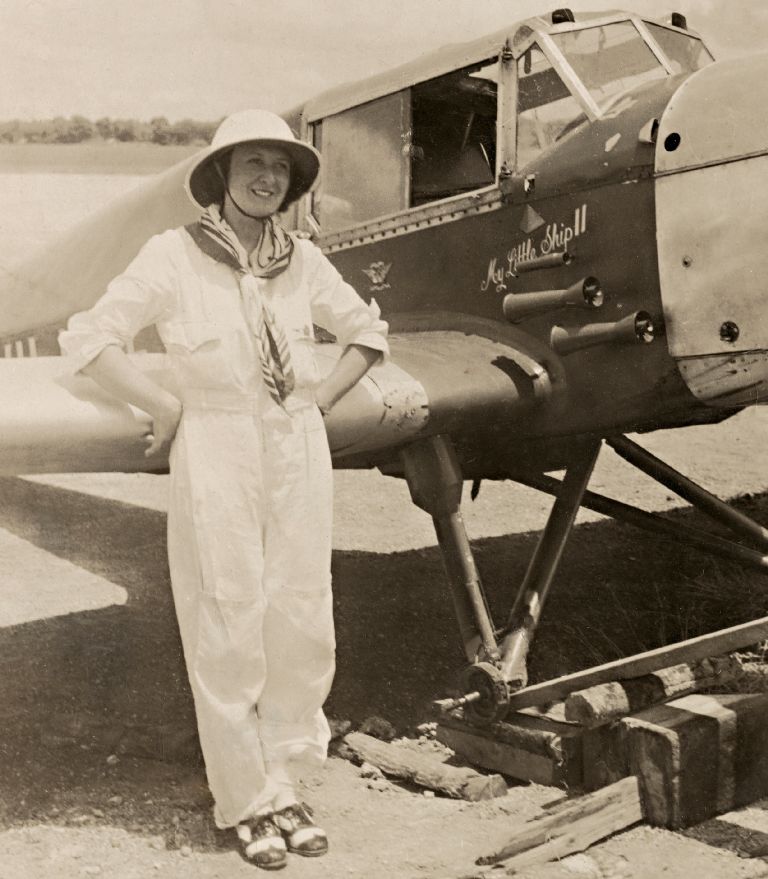
Lores and My Little Ship II during the Australia-South Africa Flight - image courtesy of the National Library of Australia
Lores Bonney's accomplishments were remarkable. In 1931, she set a new Australian record for a one-day flight by a woman and, in the following year, she was the first female to circumnavigate mainland Australia by air. in 1933, she was acknowledged as the first woman to fly from Australia to England, and in 1937 she became the first person to fly solo from Australia to Cape Town, South Africa. She was regarded as perhaps Australia's most competent aviatrix.
In 2016 Pittwater Online had the privilege of speaking with Kristen Alexander, Author of Taking Flight: Lores Bonney's Extraordinary Flying Career - well worth reading if you get a chance. The Press Copy sent here was donated to Avalon Library after the interview.
Another local lady pilot was Palm Beach resident Ailsa Craig:
Flying Couple Wed in N.S.W.
SYDNEY, Saturday. — Mrs. Ailsa Lee Brown, the widow of Dr. R. K. Lee Brown, who tragically crashed at Brighton Le Sands in April, 1934, was quietly married today at Binnaway (New South Wales) to Mr. G. U. ('Scotty') Allen, the well-known airman, now flying on the Brisbane-Singapore air mail route. Mr. Allen was a close friend of Dr. and Mrs. Brown. Mrs. Allen is also a flier, having an A pilot's licence, and the pair will have a flying honeymoon in two States. The bride is the daughter of Dr. Gordon Craig, and the wedding was held at his property. Mrs. J. F. Chambers, sister of the bride, was matron of honor, and the best man was Mr. A. Baird, chief engineer of Qantas-Empire Airways. Mr. and Mrs. Allen will make their home in Brisbane. Flying Couple Wed in N.S.W. (1935, June 22). The Mail (Adelaide, SA : 1912 - 1954), p. 2. Retrieved from http://nla.gov.au/nla.news-article57009571
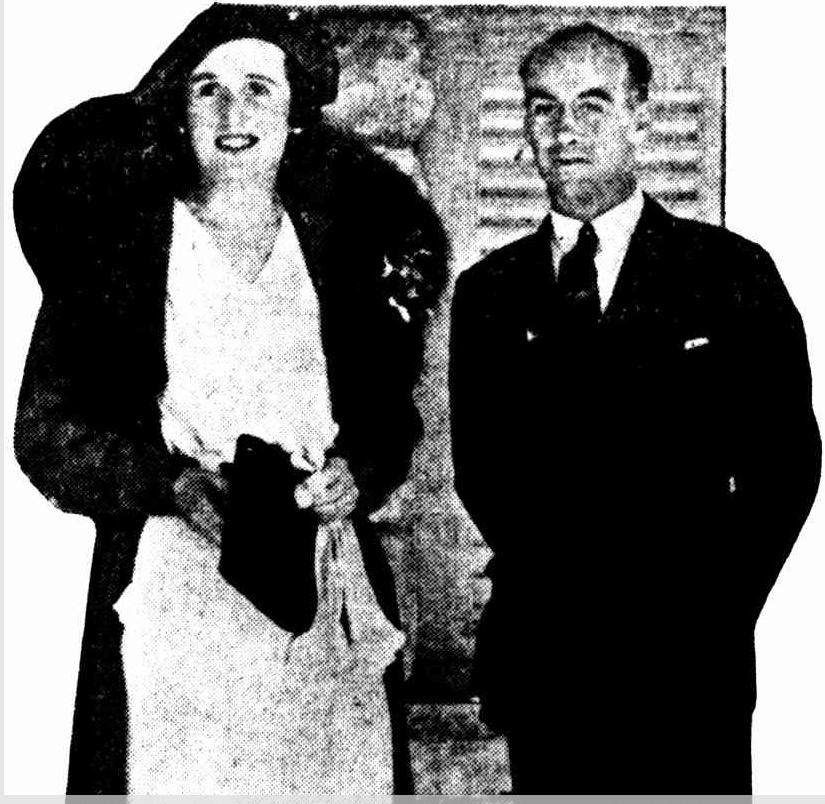
MR. AND MRS. G. U. ALLAN photographed after their marriage at the Gordon-Craig homestead, Ulinda, near Binnaway, New South Wales. The bridegroom is the well-known air mail pilot on the Brisbane— Singapore route, and the bride was formerly Mrs. Ailsa Lee Brown. No title (1935, June 25). The Courier-Mail (Brisbane, Qld. : 1933 - 1954), p. 15. Retrieved from http://nla.gov.au/nla.news-article36771694
Nancy lorna leebold (nee Ellis)
The decades when Pittwater regattas could host air races and aerial displays may have passed but one of those lady pilots who did take part in one after World War II is a Pittwater lass too. Her story, through the pages of the past tells of 'firsts' as well:
WOMEN AS WAR PILOTS
WILL women make capable war pilots? This was the question asked men and women pilots and a psychologist yesterday by a representative of the Women's Supplement, following a cable message from London stating that Miss Ursula Waldron, niece of the Marchioness of Townshend, had asked the War Ministry to grant facilities for the training of a women's auxiliary air corps.
IN making the proposal, Miss Waldron said she had suggested to one hundred girls that they should form a women's air corps, which could fight, if the need arose, beside the Royal Air Force. All of them had agreed enthusiastically with her suggestion, and she asked authority for them to train in R.A.F. machines.
But women, according to several men pilots and a Sydney woman psychologist, would not make good pilots under war conditions, since the strain would be too great.
IN PEACE-TIME.
SAID Flight-Lieutenant Norman Mulroney, president of the Royal Aero Club of New South Wales, and keen airman: "You want me in the fight, eh? Well, all I can say is women make good pilots in peace-time, but how they would react to war conditions I could not really say. No man, for that matter, who hasn't been through war, can say with any definiteness how he's going to take shellfire. So how can I tell you how women would react?
"In the last war women made fine ambulance drivers. In the next perhaps they might make good war pilots. Who can tell?"
Captain P. G. Taylor, well-known and highly skilled pilot, whose exploits would fill pages in any history of Australian flying. was the next pilot interviewed. His comments were against women being employed on active service in the air.
He declared that, while he had no doubts whatsoever of the ability of women to fly or of the courage with which they would face war conditions, he thought that any question of women being employed on active service against the enemy would be completely unthinkable.
Against women flying on active service were the views of a well-known Sydney psychologist.
Women, she said, were too highly strung to be capable of fighting in the air. It would be too much of a strain for them. Only exceptionally built women could stand the nervous stress which air fighting would involve. Of course, there were some women who could do it. Such women, for instance, as Jean Batten, who had shown amazing courage and endurance in all her long-distance flights, and Miss Amy Johnson. the English flier.
Generally, though, the idea was not practicable
Women were built—psychologically. at least—less strongly than men, And war was a man's job. He was more suited to the work.
Mr. Goya Henry, well-known New South Wales pilot, said: "While there is no denying the capacity of women to make efficient pilots. I would be sorry to see them engaged on active service in the air.
"Remembering, though the extraordinary assistance which they gave in the last war. I do think that a trained women's air force would be of great defence value, if only to relieve the men fliers in their lighter tasks."
Women pilots who were interviewed all considered the scheme for a women's auxiliary air force excellent, and thought it of practical value.
Miss Nancy Edwards, who has been flying now for over a year, and is a keen Aero Club pilot, said she thought the idea quite excellent, and that plenty of women would volunteer if an Australian corps were formed.
Asked whether she considered women capable of. standing the strain of active service. Miss Edwards said she did not think the strain would be any greater than that involved in ordinary flying. WOMEN AS WAR PILOTS (1938, May 10). The Sydney Morning Herald (NSW : 1842 - 1954), p. 21 (Women's Supplement). Retrieved from http://nla.gov.au/nla.news-article17463915
Mona Vale and Narrabeen can claim another first for women flyers in resident Nancy Ellis. A few insights from the ages of the past:
GIRL IN AIR RACE
A woman pilot will take part in - an air race from Mascot to Broken Bay, as part of the Pittwater Regatta programme on Boxing Day. She is Miss Nancye Ellis, of Mona Vale, who holds the only B class commercial licence in NSW. Miss Ellis started flying with the Royal Aero Club in 1942, and secured her A ticket in June, 1943.
The four other pilots, all ex-RAAF personnel, are: Tony Liggins, Randwick; R. W. Crawford, Dulwich Hill; Hugh Hamilton, Strathfield; John Pope, Bellevue Hill. The planes, all Tiger Moths, will leave Kingsford Smith Aerodrome at 3.15 pm on Boxing Day and fly via Manly golf links, Bay View, Mona Vale, and Goddard's wharf, Palm Beach, before turning to the RMYC clubhouse at Broken Bay. Pope will give an aerobatic display on arrival at Broken Bay. GIRL IN AIR RACE (1947, December 23). The Sun (Sydney, NSW : 1910 - 1954), p. 17 (LATE FINAL EXTRA). Retrieved from http://nla.gov.au/nla.news-article230561456
Sydney Woman Becomes Flying Teacher
The only woman in Australia to hold a valid flying instructor's certificate is Miss Nancy Ellis, of Mona Vale.
Miss Ellis, who is a pilot member of the Royal Aero Club of NSW, recently passed her flying instructor's examinations and qualified as a first class radio operator. She hopes to fly for an established flying school or conduct her own flying school.
It is understood that the only other woman in Australia to qualify as a flying instructor is Miss Freda Thompson, recently elected president of the Royal Victonan Aero Club.
Aviation authorities said that Miss Thompsons instructor's licence was now invalid because she had not flown the required number of hours each year to retain it.
Miss Ellis said yesterday ''I fly for the love of it mainly.
'Practising acrobatics is one of my favourite flying pastimes " Sydney Woman Becomes Flying Teacher (1948, September 2). The Sydney Morning Herald (NSW : 1842 - 1954), p. 5. Retrieved from http://nla.gov.au/nla.news-article18083400
NANCY LORNA ELLIS - FLYING INSTRUCTRESS
Dominant males who delight in rolling off cliches about the weaker sex might try matching their accomplishments against those of Miss Nancy Lorna Ellis, only woman flying instructress in Australia.
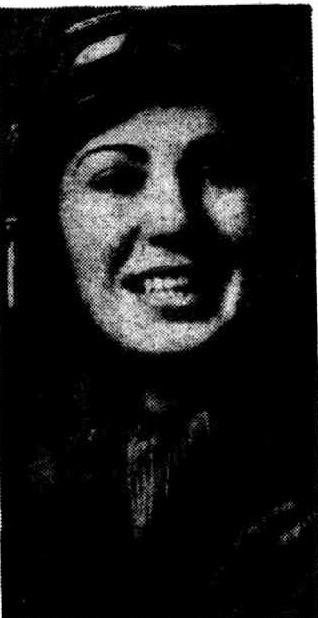 MOST of them will probably end up with shattering inferiority complexes, for this charming brunette, apart from holding a pilot's licence permitting her to fly more than a dozen different types of planes, is a highly-skilled mechanic and aircraft technician. She's also a glider pilot, draftsman, accomplished surfboard rider and .ballroom dancer, holds a first-class radio operator's licence, and was the first woman technical officer ever to be admitted to the Department of Aircraft Production during the war.
MOST of them will probably end up with shattering inferiority complexes, for this charming brunette, apart from holding a pilot's licence permitting her to fly more than a dozen different types of planes, is a highly-skilled mechanic and aircraft technician. She's also a glider pilot, draftsman, accomplished surfboard rider and .ballroom dancer, holds a first-class radio operator's licence, and was the first woman technical officer ever to be admitted to the Department of Aircraft Production during the war.
Miss Ellis was born in Adelaide and was still in rompers when her father, the late John Eric Ellis, an electrical engineer, first introduced her to the oil-smeared mysteries of engines. When her father opened a garage at Vaucluse, Sydney, she soon became an accomplished motor mechanic. In her early teens she could pull down a car engine, change a tyre, or tune up a motor as efficiently as any tradesman.
Right-Hand Man
After completing her studies at Cleveland Street High School, Sydney, Miss Ellis became her father's right-hand man in the garage, and when he opened a second garage at Narrabeen, he was so confident of her skill that he gave her complete control of the new business.
At the outbreak of war, Nancy Ellis felt there must be some place in the war effort where a young woman could make herself useful — and there aren't many women or men, either, who made themselves more useful to the war effort. In her spare time she trained as a draftsman and secured a position in the airscrew division drawing office at the De Havilland plant, Alexandria, Sydney.
To make herself more proficient, Miss Ellis concentrated on a correspondence course of aeronautical engineering and began training for her pilot's licence. Then she upset the Public Service equilibrium by obtaining a post on the technical staff of the Department of Aircraft Production. It was unheard of for a mere woman to enter that sacred male preserve. In the first place, there was no such classification as a woman technical officer and women couldn't be expected to discover faults which developed during the assembly of aircraft and efficiently test new aircraft materials.
Sets Precedent
It's true most women couldn't, but it was obvious that Nancy Ellis could and so a new classification for women technical officers was created in the Department. Seldom working less than 16 hours a day she did her training flights in the morning, spent the rest of the day working in her capacity as a technical officer and devoted her evenings to studying her aeronautical engineering course. Women pilots were not supposed to fly during the war; there was an official ruling on that subject, but it wasn't applied to Nancy Ellis.
She agreed that it was vitally necessary for men to be trained as pilots, but considered a well-trained woman would be an asset to the company.
And so she flew planes, but not merely for the fun of joy-riding through the skies. At the end of a day's, work, or during her lunch hours, she would change over from aircraft production work to Army co-operation flying, taking any single-seater plane up to heights of never less than 10,000 feet and give the A.A. gunners something to practise on.
Miss Ellis is one of the few flyers who succeeded in wheedling enough petrol out qf the Department of Civil Aviation during the hard days of rationing to secure her commercial pilot's licence.
Miss Ellis enjoyed flying so much herself that she considered she should share the pleasure with others, so, about two years ago, she applied for a flying instructress's licence and passed one of the strictest of all flying tests to qualify.
To-day, as far as records show, she's the only woman flying instructress in Australia, and to hold her licence she, like all other instructors, must undergo a strict medical examination every six months, and, of course, her flying ability must not be allowed to deteriorate. Other women have held flying instructresses licences in Australia but have allowed them to lapse.
To-day Miss Ellis is an instructress with the Truscott Flying Club and has put dozens of fledglings through the loops. One of her major ambitions now is to create an official Australian altitude record for women. She's waiting for satisfactory weather conditions, including a good westerly wind to give that extra lift required by altitude record makers and breakers. NANCY LORNA ELLIS (1950, July 8). Smith's Weekly (Sydney, NSW : 1919 - 1950), p. 15. Retrieved from http://nla.gov.au/nla.news-article235987611
Nancy Lorna Leebold (née Ellis), (2 November 1915 – 13 July 1982) was an Australian aviator and the first female commercial pilot in Australia. She was also the first woman in Australia to co-pilot a commercial airliner carrying passengers, fly as a first officer on a commercial aircraft, secure a first class wireless operator's licence and be endorsed to fly heavy aircraft. At one stage in her career she was also the only female member of the Institute of Aeronautical Science in New York and the only female flying instructor in Australia.
Born in Adelaide, her mother was Emilene May, née Webber and her father, John Eric Ellis. After graduating from Cleveland Street High School, Ellis's father gave her control of his second garage at Narrabeen. Following the outbreak of World War II, Ellis studied to be draftsman and began working at De Havilland. During this time she took a correspondence course in aeronautical engineering and commenced her training as a pilot. During World War II, she was the first female technical officer to be admitted to the Department of Aircraft Production.
Her Father passed away in 1946, the death registered at Manly: NSW BDM's - ELLIS JOHN ERIC HORNER 28802/1946 Parents: WILLIAM MARY ANN COOPER Registered at: MANLY
Her mother passed in 1964: NSW BDM's - ELLIS EMILENE MAY20423/1964 Parents: THOMAS ROBERT SARAH EMILY Registered at: RYDE
Women Pilot's - Form Assn.
Sydney. - Forty-nine, of Australia's women pilots formed the first Australian Women Pilots' Association here yesterday. Mrs. R. G. Casey, wife Of the Federal Minister for Development, was elected patron, and Mrs. Nancy Walton (the aviatrix Nancy Bird) is the first president. Miss Nancy Ellis, treasurer, is the only woman flying instructor in Australia. Women Pilot's Form Assn. (1950, September 19). Barrier Miner (Broken Hill, NSW : 1888 - 1954), p. 9. Retrieved from http://nla.gov.au/nla.news-article49579196
WILL PILOT HER OWN PLANE TO CONFERENCE
BECAUSE flying duties as a co-pilot on an airways cargo line will prevent Miss Nancy Ellis attending the Jubilee women's conference at Canberra as the delegate of the Australian Women Pilots, she will be replaced by Miss Freda Thompson, who will fly her Hornet Moth to Canberra on October 11.
Miss Thompson has been flying continuously for 20 years. In 1934 she flew a Tiger Moth solo from England to Australia.
The Federal president of the Australian Women Pilots, Mrs. Nancy Walton, will be unable to attend the conference as she is organising a garden party for the Flying Doctor Service to be held at her home at Pymble on October 12. WILL PILOT HER OWN PLANE TO CONFERENCE (1951, September 27). The Sydney Morning Herald (NSW : 1842 - 1954), p. 12. Retrieved from http://nla.gov.au/nla.news-article18232756
AUSTRALIA'S WOMAN PILOT
Tall, vivacious Nancy Ellis, of Ashfield, New South Wales, has become the first Australian woman, and one of the select few in the world, to co-pilot a commercial airliner carrying passengers on a regular run.
She is also the first woman in Australia to fly as first officer in a commercial aircraft, first woman to secure a first class wireless operator's licence first woman to have a heavy aircraft endorsement in Australia, only woman flying instructor in Australia and one of two women gliding instructors in Australia.
Following a listing of her considerable technical experience, she has become the only woman member of the Institute of Aeronautical Science in New York.
These distinctions did not come easily. They involved selling her business interests and working up to 16 hours a day with the single minded intens-ity which a love of flying in-spires. They were gained by a risorous routine of training flights in the mornings, days spent working as a technical officer and craftsman and evenings devoted to studying a course in aeronautical engineering.
She sold a garage and hard-ware business to concentrate solely on flying. So far she has logged almost 1000 hours and has endorsements to fly 14 dif-ferent types of aircraft. These days her post as first officer with an air cargo concern de-mands that she be "on call" at all hours for jobs as varied as lifting bales of precious wool from flood-bound properties in Western New South' Wales to ferrying the English speedway team around Australia.-"Australia." AUSTRALIA'S WOMAN PILOT (1951, October 19). Morning Bulletin (Rockhampton, Qld. : 1878 - 1954), p. 3. Retrieved from http://nla.gov.au/nla.news-article57123695
In 1953, she was the only Australian member of the Ninety-Nines and the winner of their Silver Jubilee Scholarship in the United States of America in 1954. The Ninety-Nines is the International Organisation of Women Pilots, also known as The 99s, is an international organisation that provides networking, mentoring, and flight scholarship opportunities to recreational and professional female pilots. As of 2018, there are 155 Ninety-Nines chapters across the globe, including a 'virtual' chapter, Ambassador 99s, which meets online for those who are too busy or mobile to be in one region for long.
The organisation was founded on November 2nd, 1929, at Curtiss Field, by 26 licensed women pilots for the mutual support and advancement of women pilots. Amelia Earhart had called for a meeting of female pilots in 1929 following the Women's Air Derby. All 117 women pilots licensed at the time were invited, and the group is named for the 99 of them who attended the meeting or expressed an interest in forming a group. In 2014, the Ninety-Nines was inducted into the International Air & Space Hall of Fame at the San Diego Air & Space Museum.
Miss Nancy Ellis Is Member of World Wide Group
Dubbo flying instructress, Miss Nancy Ellis, is the only Australian member of an international women pilot's association, the '99's.' Formed in 1&29 by an American, Miss Amelia Earheart, ,the organisation aims at providing a close relationship among women pilots.
The suggestion for the name came from Amelia Earhart, the organisation's first president, who suggested that it be named after the number of original members — 99.
As well as many sections and charters in the United States, there is a Canadian Section with three charters. ' There are also members in France, Brazil, South Africa and Sweden. Now a 28-years-old American, Miss Amalie Stone, of Greenville, South Carolina, wants to form an Australian charter. Miss Stone arrived in Australia recently from New Zealand, where she formed a charter. Vice-president of the '99's' last year, Miss Stone won the Amelia Earhart Scholarship in 1950. The scholarship is awarded to a woman who intends to make aviation her life's work. Miss Ellis, who has been a member of the organisation for several years, said that she had investigated the possibilities of forming a charter in Australia, but the dollar restrictions at the time had made it impossible. Now that these had been eased, it only needed a good leader to get the movement under way.
Great Value
'There are comparatively few licensed women pilots in Australia and the charter formed would only be a small one, but it would be of great value to those who joined as it would mean an interchange of ideas and interests with other nations,' she said. 'The organisation would also be of help in aeronautical research, air racing events, acquisition of aerial experience, maintenance of an economic status in the aviation industry and administering help by air in times of emergency arising from fire and flood.' Each year a Transcontinental Air Race was organised and conducted by the she said.
There were 19 entrants in the first transcontinental air race for women, held the first year the '99's' were formed. Not until World War II did the '99's' realise the full significance of their pledge to their country— 'to administer through air in times of emergency.'
'A group of 26 volunteers, organised by Jaqueline Cochran, then the National president of the movement, were serving in England as ferry pilots of all types of military and transport planes with the Air Transport Auxiliary, women's section,' Miss Ellis said. 'While 'Jackie' Cochran was still in England supervising the girls there, a second group of American women' pilots stood by for travel orders.
'Finally, the United States Government stepped in and Nancy Love was asked to organise the United States Women's Auxiliary Ferrying Squadron. 'Subsequently, Miss Cochran returned from England and, in the face of a need for more women pilots, instituted the training programme for the Women's Air Force Service Pilots — the | famous WASPS.
'While tractors were still lumbering over the dusty earth of a Wilmington airfield, in the Atlantic coast state of Delaware, Betty Gillies, mother of three children and wife of a flier and aircraft executive, became commanding offcer of the base.
'Later, several other women pilots, paying their own expenses, worked out a programme which later became the standard for the whole training scheme. 'A thousand women served in the WASPS. 'Ruth Cheney Streeter, a flying grandmother who earned her commercial rating in middle age, a pilot in the CAP (Civil Air Corps), became head of the women's marine corps. 'And she is a member of the '99's' too.' Miss Nancy Ellis Is Member Of World Wide Group (1953, February 6). The Dubbo Liberal and Macquarie Advocate (NSW : 1894 - 1954), p. 5. Retrieved from http://nla.gov.au/nla.news-article132602664
Nancy went to America via an Amelia Earhart memorial scholarship granted by the Ninety-Nines.
WOMAN PILOT FOR AIR CONFERENCES
Australia's most highly qualified woman pilot, Miss Nancy Ellis, will leave by P.A.A. to-day for America but when she returns next year it will be in her own twin-engined plane.
During her year's holiday abroad-in between attending aeronautical conferences and inspecting aircraft factories, Miss Ellis plans to buy herself a plane, and to fly it back to Australia, probably carrying freight.
For although she has flown "everything from a Lockheed Lodestar to a Tiger Moth," she has never had a plane of her own.
Flying is a full-time job for Miss Ellis, who is a commercial pilot, an instructor, and a radio operator. And although her work has taken her over most of Australia, this will be her first trip abroad.
"It's been carefully arranged," she said, "to fit in with three air conferences the annual meeting of the Institute of Aeronautical Science in San Francisco later this month, the annual convention of the famous '99 aero club at Ashville, South Carolina, early in July, and the meteorological conference of the International Civil Aviation Organisation in Montreal."
From America Miss Ellis will go on to tour England and the Continent. WOMAN PILOT FOR AIR CONFERENCES (1954, June 15). The Sydney Morning Herald (NSW : 1842 - 1954), p. 6. Retrieved from http://nla.gov.au/nla.news-article18433881
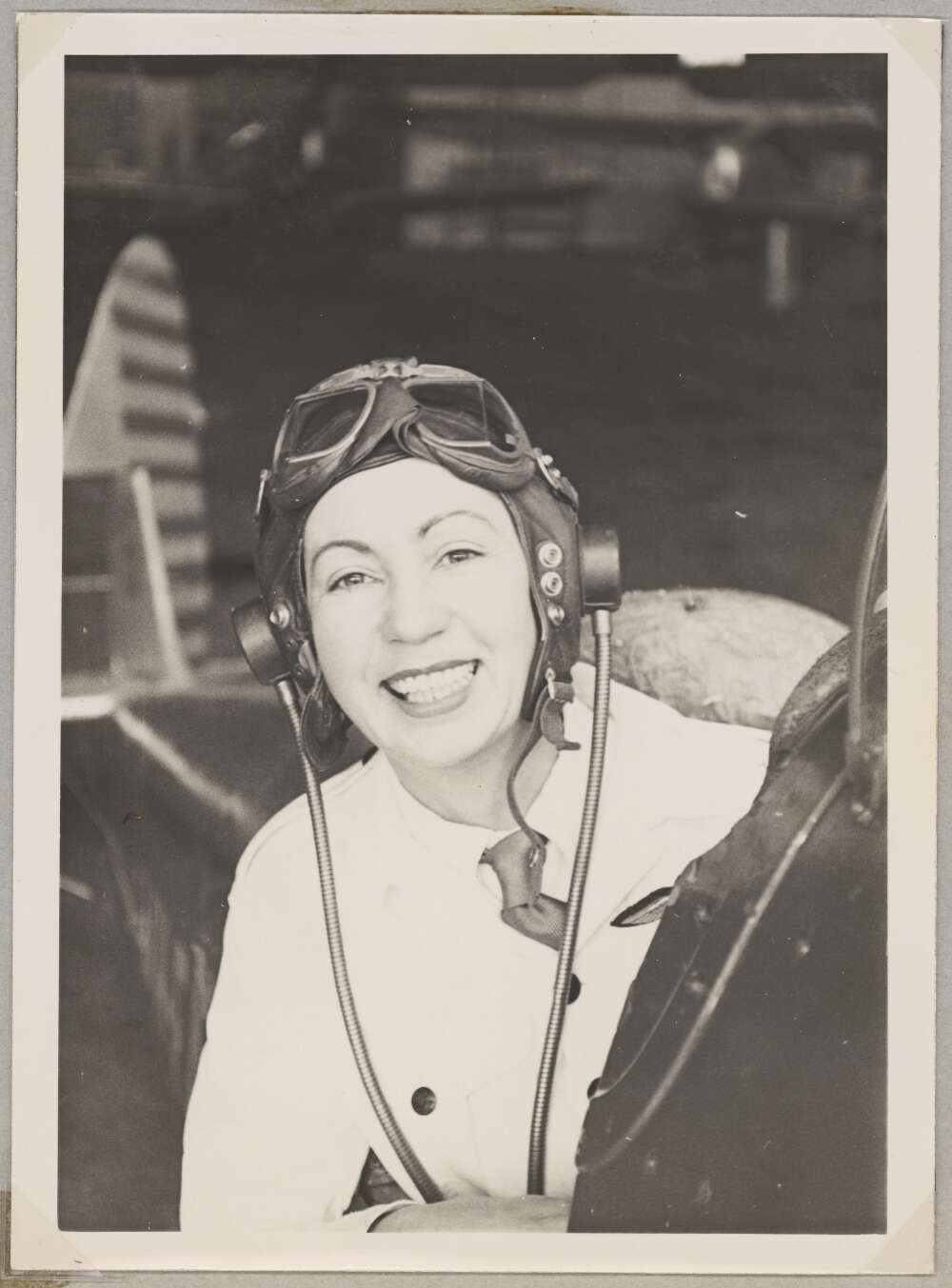
(1954). Portrait of Australian Women Pilots' Association member Nancy Leebold (nee Ellis) wearing flying suit in the cockpit of a biplane, May 1954 Retrieved from http://nla.gov.au/nla.obj-141238439
Nancy married Arthur Leebold, a sales manager and fellow pilot, on February 19th 1955 at the parish church of St Paul, Onslow Square, London. They flew back to Australia together, the Australian Women Pilots’ Association giving her the Evelyn Follett award for the year’s most worthy flying performance.
England-Australia By Woman Pilot
SYDNEY, June 21. - The first woman pilot to fly a light plane from England to Australia since the end of World War 2 reached Sydney today. The woman, Mrs A. Leebold, formerly Miss Nancy Ellis landed her small two-seater, single-engined aircraft at the Bankstown airport. She is accompanied by her husband, Mr Arthur Leebold. Mrs Leebold ferried the Miles Messenger aircraft to Australia for its owner, Mr. Cliff Wynne, of Victoria. England-Australia By Woman Pilot (1955, June 23). The Central Queensland Herald (Rockhampton, Qld. : 1930 - 1956), p. 20. Retrieved from http://nla.gov.au/nla.news-article79250821
Nancy spent two years working for Rolls Royce of Australia Pty Ltd on aeroplane engines on her return and then toured New Zealand on an aerial agricultural study. In 1959 she flew a jet aircraft in the USA, the first Australian woman to do so. Back in Australia, she ran her own business, Avmar Pty Ltd, which imported aircraft and marine accessories and undertook charters. A fellow (1965) of the Australian Institute of Navigation, in 1967 she became its first woman president. That same year she was appointed MBE.
A tall, slim, dark-haired and good-looking woman, usually dressed in smart slacks, Mrs Leebold had a vivacious manner. She died of Alzheimer’s disease on July 13th 1982 at Waterfall, the southernmost suburb of Sydney in the eastern corridor, bordering the Illawarra region, and was cremated. Her husband, who survived her, had said that she was an engineer at heart with a childlike curiosity, particularly about the sea and the sky. The couple did not have any children.
Australian history is filled with brilliant women pilots, while today's women pilots in the R.A.A.F. are taking it to the limit, especially in this, their 100th year: airforce2021.airforce.gov.au
An R.A.A.F. webpage on 'Female Firsts' provides:
Female “Firsts” in the Air Force
Pilots
The first female Royal Australian Air Force pilots were Flight Lieutenant Robyn Williams and Officer Cadet Deborah Hicks. Both graduated from the same flying course (No 144 PLTCSE) on 30 June 1988.
Officer Cadet Hicks flew Mystere VIP aircraft at No 34 SQN and discharged in 1994.
Flight Lieutenant Williams went on to qualify as a flying instructor in 1992 before undergoing test pilot training in the UK. After serving with the Aircraft Research and Development Unit, she was promoted to Squadron Leader and posted to the US for five years. There she led the resident Air Force project team taking delivery of new C-130J Hercules. Promoted to Wing Commander in March 2000, she returned to Australia later that year to manage the C-130J program office.
Engineers
The first female engineer is less clear. On 1 February 1978, the Air Force appointed its first female engineering student, Pilot Officer Margaret Maxwell. It appears that she had already completed two years of tertiary education as an engineer before enlisting, because in 1980 she was posted to an Aeronautical Engineering position.
On 21 August 1979, the Air Force appointed Flying Officer Rosalea Hotchkies as our first qualified engineer. She was a direct entry Radar Engineer.
Female pilots
There are no restrictions on employment of females in the Air Force, including all pilot positions.
As at February 2019, there were 752 pilots in the trained permanent Air Force, 38 of whom were women (around 5.05%). There were 498 Officer Aviation Cadets under training, 126 of whom were women (25.3%).
Air Force actively encourages women to apply to fly fighter jets, and in December 2017, we graduated our first female fighter pilots from the Operational Conversion Unit at RAAF Base Williamtown. Like their forebears, these graduates completed the same course requirements as their male peers and have joined a growing cadre of women successfully flying fighter jets around the world, including in the United States, France, Turkey, Israel and other nations.
Air Force has implemented several programs to assist women who choose a pilot career. Entry to the Graduate Pilot Scheme is open to women who are currently undertaking a Bachelor of Aviation (BAv). Once qualified, women pilots are able to access the Flying Females Mentoring Network.
Men and women are required to undergo the same basic fitness tests to become a pilot; however the standards are different for age and gender. For some roles, the requirement cannot be adjusted for safety reasons.
Female aircrew
Women are eligible to fly as aircrew on all aircraft or control aircraft in the Air Force.
As at February 2019, there were 250 female Officer Aviation and Airmen aircrew in the Air Force, with another 143 undergoing training. This includes Officer Aviation jobs such as:
- fast jet and fixed wing pilots
- air battle management, airborne electronics, air mobility, maritime patrol and response, and weapons systems officers
- Air Traffic Controllers, and
- Officer Cadet Trainees.
It also includes Airmen Aircrew jobs such as:
- Airborne Electronic Analysts
- Crew Attendants, and
- Loadmasters.
Air Force's commitment to improving gender diversity is demonstrated through a comprehensive Gender Diversity Strategy. Initiatives include mentoring for female members, strategies for improved flexible working arrangements, and support for new parents.
Australian Women's Pilot Association membership
We pay for our female pilots to be members of the Australian Women's Pilot Association. This sponsorship provides an invaluable mentoring and professional development opportunity for female Air Force pilots to engage with other female pilots outside the military network.
Air Force sponsored flying scholarships
Each year the Chief of Air Force awards two scholarships to young women under the age of 24. The scholarship is designed to assist young women in the costs of pursuing a career in aviation.
The R.A.A.F also provides Air Force Camps for women. Female students in years 10, 11 and 12 from QLD, NSW and the ACT are selected to participate in a series of events - after which 100% of participants said that they intend to apply to join the Air Force.
The camps run over several days and provide young women aged 16-24 with an opportunity to explore the exciting aviation, engineering and technical trade careers available within the Air Force. As well as being exposed to military aviation operations, participants also experience the day to day routine of an Air Force base, and have several opportunities to engage with Air Force personnel and Defence Force Recruiting specialists to discuss possible careers in the military.
This all reiterates that the first defence service in Australia to allow women to don a uniform is maintaining a 'the sky is not the limit' ethos when it comes to women who refuse to accept their gender as a basis for being excluded from anything.
Birds? Sometimes.
Pilots of our own destinies? Always!
References and Extras
- TROVE - National Library of Australia
- National Library of Australia
- State Library of NSW
- The Oaks - La Corniche
- Walter Burley Griffin Lodge - NSW Office of Environment & Heritage, NSW Department of Planning, Industry and Environment
- Pittwater Regatta Air Race Trophies: From 1934 And 1935 And The Pilot Who Saved William Hughes
- Taking Flight: Lores Bonney's Extraordinary Flying Career
- Muriel Knox Doherty
- Ships Biscuits - The At Sea Necessity That Floated William Arnott’s Success
- Pittwater Summer Houses: The Cabin, Palm Beach - The Pink House Of The Craig Family
VETERANS OF THE AIR
THREE women- "veterans of the air" - who learned to fly Tiger Moths at Mascot more than 20 years ago, and 42 men met for dinner at the Royal Aero Club last night.
They were Mrs. Arthur Davis (Cammeray), whose licence is No. 98, obtained on August 17, 1927; Miss Evelyn Follett (Castlecrag), licence No. 109, dated August 29, 1927; and Miss Meg Skelton (Rose Bay), licence No. 634, October 31, 1930.
Mrs. Davis and Miss Follett were the second and third women respectively in Australia to fly. When clubs were established in other States, several women obtained their licences, and many women - who were not present at last night's dinner - obtained their licences in N.S.W. earlier than Miss Skelton.
Of the three Sydney women at the dinner last night, only Miss Follett is to-day connected with aviation; she is a director of Ad Astra Airways.
A toast to "absent friends" - which meant before-1930 licence-holders - which was proposed by a foundation member of the club (1919), Mr. H. D. Arnott, included several women, among them his cousin, Miss Phyllis Arnott. VETERANS OF THE AIR (1953, June 24). The Sydney Morning Herald (NSW : 1842 - 1954), p. 9. Retrieved from http://nla.gov.au/nla.news-article18367467
AERIAL PAGEANT - QUEENSLAND PILOT'S SUCCESS.
MR. L. J. BRAIN WINS DERBY HANDICAP.
SYDNEY, April 1
More than 30 aeroplanes participated in Saturday's aerial pageant, which was the most successful of its kind ever held in the Southern Hemisphere. Mr. L. j. Brain, the Qantas pilot, was successful in winning the Aerial Derby Handicap in a de Havilland Moth machine.. The attendance at the Mascot aero-drome was estimated by the police and Aero Club officials at 120,000, of whom 100,000 were in the aerodrome grounds.
In the Aerial Derby, the classic air race of Australia, four States were represented by civilian competitors, and representatives of the Royal Australian Air Force from the Richmond and Point Cook depots, and of the Civilian Aviation Department also participated. The Aerial Derby and the Aerial Derby Handicap, 42 miles, were raced simultaneously. The first aeroplane to pass the finishing line was the winner of the Aerial Derby Handicap, and the winner of the Aerial Derby was the aeroplane which completed the course in the fastest time. Twenty-three machines competed. Flight Lieutenant F. Easton was first in the Aerial Derby, and Captain E. J. Jones third, but they were both disqualified when a report was received from the observers that they, had cut out the corners. There were all kinds of aero-planes, slow, pre-war models, that climbed laboriously into the air, noisy, crack-ling' machines, which seemed to get from the starting line to a point far over he spectators' heads in one ' bound, the dainty, shining little biplanes that de-veloped amazing bursts of speed.
There was a stir in the crowd as the three women aviators appeared, rather nervously, and prepared for their race, the Oaks. It was the first race of the kind in Australia. The girls took off easily, flew their machines over the course without a tremor, took part in an ex-citing finish, and landed again gracefully. Skilled and daring pilots gave thrilling displays.
GIFT 'PLANE PRESENTED.
When presenting the officials of the New South Wales section of the Aero Club of Australia with the gift Avro Avian machine, presented by Sir Charles Wakefield, the Minister for Defence (Sir William Glasgow) said that the club might justly feel proud, for it was the most successful civil aviation training organisation in the Empire, if net in the whole world. Sir William expressed the determination of the Federal Governmei t to support in every way possible the development of civil aviation in Australia, and added that instructors and officials from other training clubs would be sent to Sydney from time to time, in order that they might imbibe some of the enthusiasm of the Sydney executive, and leam how discipline and administration should be' carried out in civil flying organisations.
The Controller of Civil Aviation (Colonel Brinsmead) stated that he had never witnessed a more successful flying meeting.
Results :
AERIAL DERBY.-De Havilland 9A, 400 h.p. Liberty engine, entrant R.A.A.F. (Pilot Flying Officer M., Mulroney), 1; flying time, 20min. 23sec.;' average speed, 124 miles an hour. R.A.A.F. (Pilot, Flying Officer Jones), 2; flying time, 21m.u. 17sec.; average speed, 118 miles an hour. Widgeon II., Amphibian. 400 h.p. i Jaguar engine, entrant R.A.A.F. (Pilot, Wing Commander L. J. Wackett), 3; flying time, 23min. 7sec; average speed, 109 miles an hour.
AERIAL DERBY HANDICAP.-De Havilland Moth, 30/80 h.p.. Cirrus MK2 engine, entrant Qantas Ltd. (pilot, L. J. Brain), handicap 8min. 48sec., 1; Curtis JN4. 00 h.p. Curtiss OX5 engine, entrant H. W. Ross (pilot. H. W. Ross), IOmin. 23scc, 2; De Havilland Moth, 30/80 h.p. Cirrus MK2 engine, entrant Golden Aircraft Co., Ltd. (F. N. Drayton), Omi«.'20sec, 3.
OLD WAR DOGS HANDICAP Final ,(two laps of the course, 21 miles): Captain P. G. Taylor, scr., 1; Captain A. W. Ross, lmw- 17sec 2, Captain R. W. Reid, Imir,.. 17sec.. 3. Time, 15min. Ssec. Winner's average speed 84 mils an hour.
THE JOYRIDER'S HANDICAP ...miles.-H. W. Ross, Curtiss JX4,'3rain 47sec, 1; L. J. Brain, De Havilland Moth' Imin. Sacc, 2; H. T. Hammond, DeHavilland "X" Moth, 55sec, 3. Time,9min. 30 2/Bsec. Average speed, 66.2 miles per hour.
"THE OAKS," 10 1/2 miles, for women pilots trained by the club.-Miss M. Reardon, 1; Mrs. A. M. Upfold, 2; Miss E.M. Follett, 3. Time, 9min. 48sec. Average speed, 66 miles per hour. AERIAL PAGEANT (1928, April 2). The Brisbane Courier (Qld. : 1864 - 1933), p. 20. Retrieved from http://nla.gov.au/nla.news-article21238885
BEATRICE & EVELYN FOLLETT
(aka Bee and Pinkie)
Miss Beatrice Hilda Follett (1897 - 1978 ) and her younger sister Miss Evelyn Mary Follett (1902 - 1977) were the two younger children of Mr. and Mrs. William Follett, of Hurlstone Park. There was another sister Clara (Clara Delphine Tanner (Follett) (March 24, 1884 - August 21, 1973) the eldest child and a brother Frank William Follett (1892-1950).
Their father William Follett was a warehouseman from Devonshire in England. His wife was Ada née Dodridge. Ada died on July 28, 1926, at 'Ramornie', 136 Floss Street, Hurlstone Park.
Beatrice Hilda Follett, born 1897, Marrickville, Sydney, NSW, Australia. Died 22/5/1978, Royal North Shore Hospital, Sydney, NSW, Australia. Resided Castlecrag, Sydney, NSW, Australia. She did not marry.
Evelyn Mary Follett, born 1902, Marrickville, Sydney, NSW, Australia. Died 15/8/1977, Castlecrag, Sydney, NSW, Australia. She did not marry.
In fact the address was 111 Edinburgh Road. Castlecrag. They fired their pots in Bim Hilder’s kiln at Castlecrag - 177 Edinburgh Road, Castlecrag, a ten minute walk up the road.
From what I can make out it was not just Beatrice who had the ceramics training. Beatrice went to East Sydney Technical college in 1945 where she studied Ceramics and Sculpture. In 1946 Beatrice H. Follett did Art Modelling Stage I & Ceramics Stage II. In 1947 Beatrice was studying Art Modelling II and both she and her sister Evelyn were doing Ceramics Stage III that year. In 1949 Follett, B. H did Modelling Stage III as a Day Course. Beatrice became an associate member of the Society of Arts & Crafts of N.S.W. in 1944. Her sister Evelyn joined in 1947. By this stage they were both in their 40s and were successful businesswomen. They were part owners of an airline company founded by their brother Capt. Frank W. Follett called Adastra Airways.
Evelyn has her own place in Australian aviation history : "Miss E. M. Follett OFFICIAL information embodied in an article in this paper last week referred to Miss E. M. Follett as having secured her 'A' licence for solo flying on July 11, 1929. The actual date was two years earlier. Miss Follett received her certificate from the Aero Club in 1927." She was the third woman in Australia to receive this certificate : "Miss Evelyn Follett (Castlecrag), licence No. 109, dated August 29, 1927".
Evelyn Follett also served in the WAAAF (Women's Auxiliary Australian Air Force) as a Section-Officer during WWII. She was the RTO (Rail Transport Officer) at Central Railway Station. But there was also mention that "Sectlon-Officer Follett was engaged in 'hush-hush' work for the R.A.A.F."
This article from the Sydney Morning Herald of April 1943 tells of her service: "W.A.A.A.F. officers are now attached to the staffs of R.A.A.F. railway transport officers in most of the capital cities, and the new venture has already proved very successful.
In Sydney, although two airwomen have been on the R.T.O.'s staff for about 12 months, Section-officer Evelyn Follett has just been appointed W.A.A.A.F. welfare officer attached to the staff of the R.T.O., Flight-Lieutenant R. D. Clark. Section-Officer Follett's first responsibility is to W.A.A.A.F.s on leave or in transit. She directs them to accommodation, advises on transport to local units, directs them to their destination, if it is in Sydney, or should they have to spend a day in Sydney she tells them where to find Servlcewomen's clubs and where they can get a meal, a shower, and a rest. All the bulk transport movements of W.A.A.A.F. personnel are dealt with by the R.T.O., but Section-Officer Follett frequently arranges transport for late postings among W.A.A.A.F.s. Section-Officer Follett was the first woman to enrol and the second woman in Australia to gain her pilot's licence. She trained with the New South Wales Aero Club at Mascot. For many years she and her sister managed their own travel agency and technical library. Many young air enthusiasts who used this library are now in the R.A.A.F., and some of them are ferrying aircraft across the Atlantic. Before she was appointed to her present position Sectlon-Officer Follett was engaged in "hush-hush" work for the R.A.A.F.. Members of the A.W.A.S. are attached to the Army R.T.O. office in Sydney. They are engaged in office duties and as telephonists, and one of them checks soldiers' leave passes."
Her brother Frank William Follett (1892-1950) joined the Light Horse in 1915, then became an original member of the Australian Flying Corps, establishing a brilliant record. After the war he joined the Australian Civil Aviation Department as a test pilot. "Frank William Follett, born 27/3/1892, Marrickville, Sydney, NSW, Australia. He passed away October 25th,1950, Vaucluse, Sydney, NSW, Australia.
"Frank William Follett, aviator and aerial surveyor, was born on 27 March 1892 at Marrickville, Sydney, son of English parents William Follett, warehouseman from Devonshire and his wife Ada née Dodridge. Educated at Sydney Boys' High School, he joined the firm of Simpson Bros, engineers, in Sydney, and in May 1910 then joined the engineering department of the Metropolitan Board of Water Supply and Sewerage as a cadet draftsman and by 1916 was a compiling draftsman. Enlisting in the Australian Imperial Force in January 1916, Follett saw active service in France with the Australian Field Engineers and was later promoted sergeant and assistant technical warrant officer. After training with No. 29 Training Squadron, Royal Flying Corps, at Fern Hill, England, he was commissioned second lieutenant in the A.I.F. on 18 November 1917 and lieutenant in the Australian Flying Corps on 18 February 1918. In July 1918 in France with No. 2 Scouting Squadron operating out of Reclinghem (south-west of Aire) with S.E.5s, Follett saw much action harassing the enemy over the Lys in poor flying conditions. During the August Somme offensive his squadron helped reinforce British scouts in the Fourth Army and took part in the air-raids on Lille. In September he went back to No. 6 Training Squadron in England. Returning to Australia in June 1919, he resumed his pre-war job. On 24 April 1920 at St Paul's Catholic Church, Dulwich Hill, he married Helen Gertrude Molloy. On 2 February Follett was appointed superintendent of aircraft in the civil aviation branch of the Department of Defence under H.C. Brinsmead with headquarters in Melbourne; his work included the inspection of aircraft all over Australia and flight-testing new models. At Richmond, New South Wales, in December 1924, during Australia's first flying week for testing locally built low-powered aircraft, Follett flew departmental aeroplanes; he gained the highest number of points in the trials in a D.H.53 (but failed to beat Bert Hinkler's mileage record), and won the aerial Derby in a D.H.37. He resigned from the Defence Department in June 1929 and from July 1929 to August 1930 was manager and chief instructor of the (Royal) Aero Club of New South Wales at Mascot. In 1930 Follett founded Adastra Airways Pty Ltd which specialised in aerial surveying. In 1939, aware of the enormous potential in Australia and the lag in Australia's aerial mapping programme, he studied the latest techniques in England, the Netherlands, Switzerland and Germany, arriving home just before the outbreak of World War II. After the war the firm expanded. By 1949 it had the most sophisticated stereo-plotting equipment in Australia and received large government contracts including an 8000-square mile (21,000 square km) survey of the entire Darling River. Quiet, retiring and somewhat dour, Follett played a leading part in the development of aerial surveying and photogrammetry. His outside interests included tennis, boating, growing orchids and Legacy. He was a member of the Imperial Service Club of New South Wales and of the Royal Society of Arts, London. In 1935 he received the silver medal of the Royal Humane and Shipwreck Society. Follett died of heart disease at the wheel of his car outside his Vaucluse home on 25 October 1950 and was cremated with Presbyterian forms. He was survived by his wife; and a daughter who had predeceased him." Married Helen Gertrude Molloy, 24/4/1920, St Paul, Dulwich Hill, Sydney, NSW, Australia. Helen died 6/2/1968, NSW, Australia. Children: (1) Frances Follett. Died 1931, Woollahra, Sydney, NSW, Australia."
In August 1930 the Follett Family began an aviation company in Sydney: "Adastra Airways, Ltd. Nominal capital £3000, in £1 shares. To establish, maintain, and work lines of aerial conveyances, a school of aviation, and deal generally in all kinds of vehicles under motive or mechanical power, Subscribers: F. W. Follett, H. T. Hammond, Evelyn M. Follett, Madge Hammond, Sadie A. Youngson, Helen Follett, Beatrice H. Follett. Registered office, Sydney."
"Adastra Airways, which began in 1930 as a flying school at Mascot Aerodrome, now the site of Sydney (Kingsford Smith) International Airport. During the thirties, the company operated a regular airline service between Sydney and Bega on the New South Wales South Coast. Also during the thirties, Adastra pioneered civilian aerial photographic survey and this became their principal activity with the discontinuation of the airline service in 1940. That Adastra managed to survive the depression years is a tribute to the tenacity of its founder, Frank Follett. In the ensuing years, Adastra became the foremost aerial survey operator in Australia. Adastra mapped much of the nation's post-war development, including the enormous Snowy Mountains Hydro Electric Scheme. As we approach the centenary of powered flight, where airline crews have come to expect five star accommodation, it is important to reflect that Adastra crews routinely stayed at remote locations for months on end where the only accommodation was the tent they brought with them. Similarly, there were no limousines for ground transportation either, crews usually travelled by motorcycle and these became a regular accoutrement of Adastra Hudsons as they roamed the country.
In April 1935 the sisters set up a business in the centre of Sydney at 14 Martin Place called the 'AIR CENTRE': "The Air Centre of Sydney is an original conception, and there is nothing quite like it anywhere else in the world. There are bureaus of travel and libraries of information which include an aeronautical section, but nothing which specialises so comprehensively as does the air centre. Situated in the most central position possible, the centre comprises one large room, which, despite its technical utility, expresses in furnishing a very definite feminine character. Australia, with its air routes distinctly market on the map. To counteract the extremely concentrated and hard work of obtaining from local and overseas sources all the information required, Miss Follett and her sister indulged their pleasure and furnished their office on the most modern and attractlve lines. They were fortunate enough to have a parquet floor in the office they selected on which to build their scheme. All the furniture is made of walnut, and, apart from the decoration acquired by rounded edges, straight lines, and simple curves, it has no ornamentation at all. A huge desk which accommodates both workers occupies the greater part of one end of the room. It Is long and counter-like, and one end of it curves round, making a cosy recess, where Miss Beatrice Follett does all the secretarial work. Bookshelves, built in the modern way, with uneven- length shelves, occupy opposite walls, and hold deep blue covered library books and green-covered magazines. One corner of the room is made very cosy with a simply-designed, little writing desk with a knee-hole and deep filing drawers, one of the demure little office chairs of solid walnut upholstered in air force blue burlap to match curtains, and huge lounge chairs. In these very attractive surroundings information about all types of aircraft used throughout the world can be obtained. Information of all the latest developments of wireless, air mails, the air services of each country of the world, with special attention given to Australian services, is given. Bookings for oversea flights are being arranged, so that people intending to fly during their travels abroad will have the convenience of being able to make all their arrangements before leaving Australia."
"Nearer home— in Martin Place, centre of Sydney's tourist traffic— an aerial travel bureau is conducted by Misses Evelyn, and Beatrice Follett, sisters of the war pilot and commercial air transport operator, Mr Frank Follett, of Adastra Airways.
Miss Evelyn Follett was one of 'the first women pilots trained by the Aero Club to receive an "A" pilot's licence at Mascot, almost 10 years - ago, and, with Mrs Terry and Miss P Arnott, she was selected to form an aerial guard to welcome Miss Amy Johnson when the English girl flew to Sydney from Brisbane after her England-Australia flight. Not only do the Follett girls book flights on any of the world's airways, but they also conduct an extensive second-hand aeroplane market, and most of the second-hand plane transactions at Mascot, Melbourne, and Brisbane lately have been negotiated through them."
In 1936 and 1937 the sisters went overseas :"Miss Beatrice Follett and her sister, Miss Evelyn Follett, who returned in the Aorangi after eight months abroad, during which they visited many airports. The Aorangi was a liner that sailed on the Vancouver, Victoria, Honolulu, Suva, Auckland, Sydney run.
Beatrice H. Follett was a student at East Sydney Technical college in 1945 where she had studied Ceramics and Sculpture. Beatrice had become an associate member of the Society of Arts & Crafts of N.S.W. in 1944. Her sister Evelyn joined in 1947. By this stage the sisters would have been in their 40s and had had a successful business career and it seems Evelyn had worked with the RAAF.
Potter and aviator, worked with her sister, Miss B. H. Follett , both were associate members of the Society of Arts & Crafts of NSW. They fired their pots in Bim Hilder’s kiln at Castlecrag -177 Edinburgh Road, Castlecrag. In the 1950s the Society donated the Folletts’ bowl with Aboriginal decoration to the Armidale Teachers College (now apparently located in the New England Regional Art Museum). The Follett sisters were also said to be aviators. - From TROVE
Nancy Lorna LEEBOLD
Also known as: née Ellis
Special Achievements:
October 1952 - First Australian woman to fly a Lockheed Lodestar aircraft.
1959 - She flew a jet aircraft in the USA, the first Australian woman to do so.
Awarded Officer of the Order of the British Empire for services to Aviation.
Awarded the Evelyn Follett award by The Australian Women Pilots’ Association as the year’s most worthy flying performance.
1965 - A fellow of the Australian Institute of Navigation; in 1967 she became its first woman president.
1965 - Appointed Member of the Order of the British Empire.
February 1942 - She gained her private pilot’s licence (No.4060).
January 1946 - Gained her commercial pilot’s licence.
After World War II she was a Ferry Pilot of war surplus R.A.F. planes to their new owners.
1948 - She qualified as a flying instructor and two years later as a gliding instructor.
1952 - She was appointed chief flying instructor at Dubbo Aero Club.
1953 - Was awarded Queen Elizabeth II’s coronation medal.
NEW-MEMBERS WELCOMED Air Force Officers' Wives Meet
The Association, which was formed by the Air Force Officers' Wives and Mothers to help the After Care Home of the Melbourno District Nursing Society, is a very live organisation, with Mrs R. Williams, wife of Group-Captain Williams, as president, and Mrs R. R. Walne, honorary secretary. Though only a year old, the Association has 70 members, all keenly Interested in the work of the home. At the monthly meeting this afternoon a good deal of business was discussed In preparation for the annual meeting on April 8. The constitution was drawn up, and nominations received for office- bearers. Several new members were welcomed. among them Mrs M. Spleer, wife of Wing-Commandor Spleer, of the Royal Air Force, who recently arrived from England; Mrs Brown, wife of Flying-Officer Brown; Mrs Bell, wife of Flight-Lieutenant R. Bell. Mrs Bell recently returned from England, where her husband was doing a special Instruction course. During that time she seized the opportunity to qualify for a pilot's certificate. Over a cup of tea these new members were able to give some brief Ideas of similar work in England. Woman's World (1928, March 21). The Herald (Melbourne, Vic. : 1861 - 1954), p. 11. Retrieved from http://nla.gov.au/nla.news-article243910046
VICTORIA'S FIRST AND ONLY WOMAN PILOT
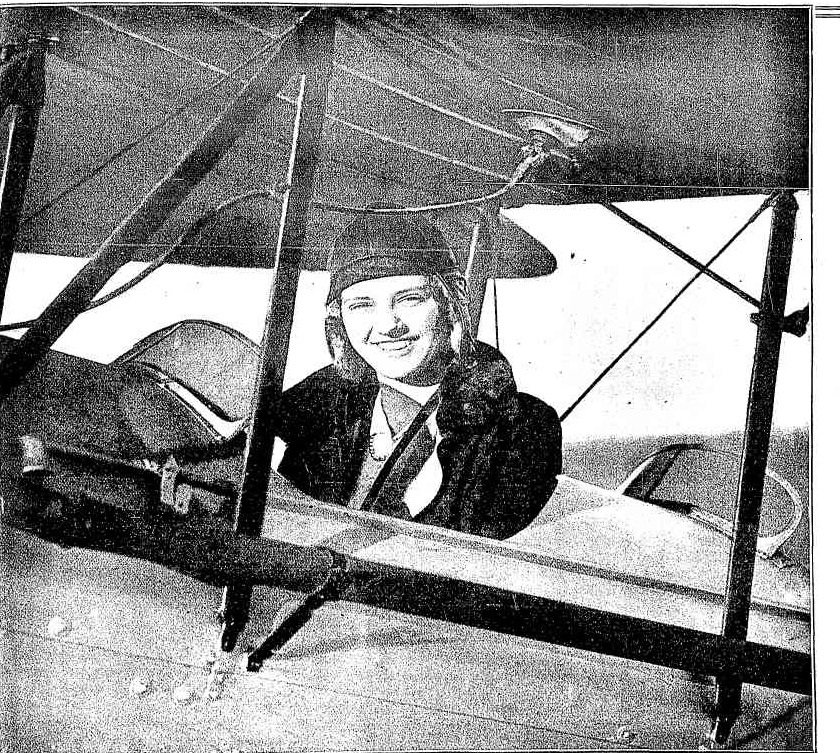
To Mrs C. N. McKay belongs the honor of being the first and only woman pilot of Victoria. Last week she flew "solo" for the first time, and with that ordeal now safely behind her she is expected to "get her ticket" in a few days. Her husband is President of the Aero Club of Victoria and both are keenly interested in aviation, but Mrs McKay, so far from being proud of her solitary distinction, only hopes that other women will join her as flying members of the Aero Club, now that she has "broken the ice" so to speak. VICTORIA'S FIRST AND ONLY WOMAN PILOT (1928, May 24). Table Talk (Melbourne, Vic. : 1885 - 1939), p. 3. Retrieved from http://nla.gov.au/nla.news-article146562657
FIRST WOMAN PILOT
Miss K. Bloomfield, Charnwood Grove, St. Kilda, the first woman to obtain her pilot's licence in Victoria, completed her course and became a fully qualified pilot today at the Essendon Aerodrome. '
She afterwards' flew the plane and went through some stunts to show her ability. FIRST WOMAN PILOT (1929, May 15). The Herald (Melbourne, Vic. : 1861 - 1954), p. 5. Retrieved from http://nla.gov.au/nla.news-article244449061
How A. T. C. trains fledglings far future service in the air
Nowadays when a rookie enters the R.A.A.F. it's two to one that he enters with a good idea of what to expect in the Service. Not only has he done preliminary training in technical subjects, but he's well primed on Service routine, down to details like folding his blankets in the miraculously neat Service manner.
HE knows all about such Service mysteries as substantive, temporary, and acting ranks, and he can talk glibly in that language of initials so beloved of the Ser-vices, and so maddening to female companions.
All this is due to the Air Training Corps-for boys between 16 and 18 - which has supplied 5000 R.A.A.F. enlistments for the Com-monwealth, and which keeps up a steady flow of the Service intake. Recently one month's figures showed that 70 per cent, of the in-take for air crew was drawn from thc A.T.C. Permanent camp
AT Avalon, N.S.W., there is a camp for these lads. The Avalon camp is the only permanent A.T.C. camp in Australia, and has an ' R.A.A.F. staff. A steady flow of .A.T.C. squadrons from all over the State passes through this camp, each group spending a week.
When the boys go into this camp, with its Service-style huts set in a glade among cabbage palms and flowering gums, and within a mile of th»- sea, the first thing they're told is that this week isn't going to be a holiday.
They find their day lasts from 6 a.m. to 10.30 p.m., that it follows closely the routine of physical training, study, and fatigues that they'll have when they enter their R.AA.F. rookie ramp.
"It isn't a loaf, if that's what you mean by a holiday," said one lad, "but it'll do me."
A smart 16-year-old sentry salutes at the entrance. He sets the keynote for a camp which, except for the youth of its inmates and perhaps just a little less formality, conforms in every respect to an adult establishment. That is, it conforms outwardly. There is the notable variation that the boys LIKE guard duty.
Once an exasperated A.T.C. instructor said to some rookies: "If you fellows don't behave I'll put you all on guard duty."
"Can we?" shouted the boys.
At sixteen, handling a Service rifle for two hours at a stretch isn't a duty-it's a pleasure.
Nor are there any provosts in the A.T.C. Officers use the honor system. It rarely fails.
Camp Commandant Flying Officer E. Wood, R.A.A.F., has served with a famous bomber squadron in Northern Australia, and saw four years' active service with the A.IF. in the last war.
The Service lectures which he gives are among the most popular of the evening series of lectures, for he has a fund of stories about famous air aces whom he has known. He tells the boys of the comrade-ship between air crew and ground staff at operational stations, and of deeds by ground staff no less gallant than those of pilots.
One of the first things the boys learn on entering camp is how to fold their three blankets and "box' them in a fourth, in Air Force style, and how to leave their huts for inspection. The sight of those huts in the morning, with knife, fork, and plate, and shining boots set out in front of the bedding is enough to arouse the envy of the mother of any average boy.
It is Sergeant C. Herbert, R.A.A.F., Warrant - Officer - Disciplinary, who teaches them these points, and is also their drill and physical training instructor.
English sergeant
SERGEANT HERBERT, Southampton-born, who can't be as young as he looks, for he was wounded four times in his service with the British Army in the last war, has a back like a ramrod. In between the wars he served on merchant ships, and in this war he has had plenty of experience drilling Air Force recruits.
In his spare time, Sergeant Herbert grows vegetables and flowers round the mess huts.
Boys from the farthest corners of N.S.W. come to this camp for a week's training during their term in the A.T.C. Some are schoolboys, while others are already earning their living and obtain holidays to join their squadron in camp. Many have elder brothers in the Air Force.
The day The Australian Women's Weekly visited the camp the occupants were of Squadron 43, which has its headquarters in Canberra. But when squadrons from the Far West come down they often include boys who have never seen a city, nor the sea, and even some who had not previously travelled In a train.
Their own A.T.C. officers accompany the boys to camp. These A.T.C. officers, many of them schoolmasters, are men who are doing a splendid job voluntarily, and have undertaken special training to fit them for the work.
R.A.A.F. sergeants are loaned to the camp to instruct in such subjects as small arms, unarmed combat, and navigation, and during the week a visit to an aerodrome, and usually a flight, is arranged as well.
Fatigues aren't more popular than in any camp, but since each boy spends only a half day on fatigues, and there is a scrupulous oversight to see that none gets more than his fair share of the "dirty work," the lads take it cheerfully. Kitchen fatigues mean plenty of assistants for the cook. Normally the cook is an R.A.A.F. corporal, but recently he has been relieved by an interesting personality in 60year-old Frank Royall. Frank Royall was chief steward in the Aurora during Sir Douglas Mawson's Antarctic expedition in 1912 to 1914, and has served with the U.S. Merchant Navy during this war.
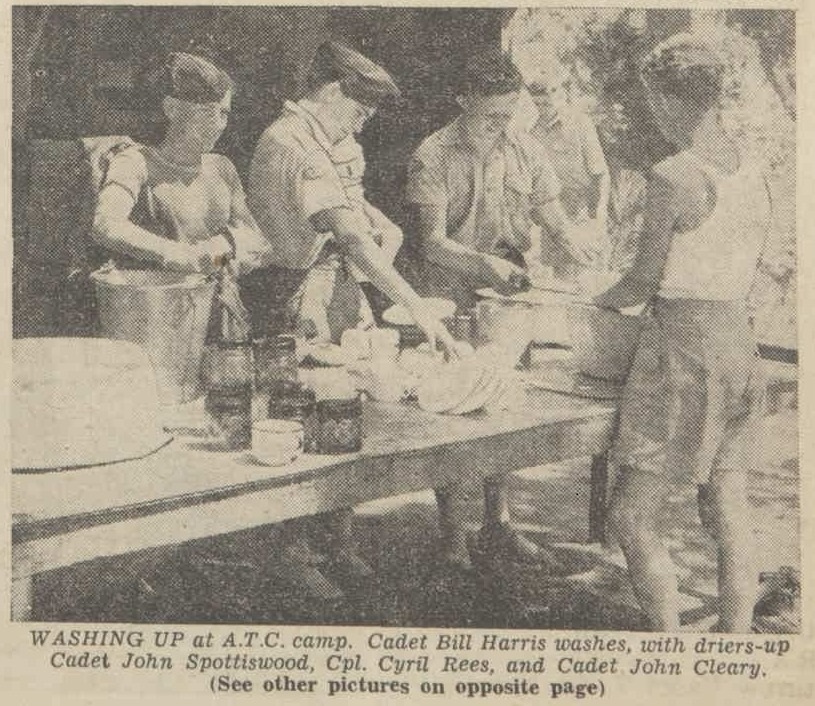
.jpg?timestamp=1615053202094)
.jpg?timestamp=1615053229444)
.jpg?timestamp=1615053255521)
.jpg?timestamp=1615053285654)
.jpg?timestamp=1615053307533)
.jpg?timestamp=1615053331537)
.jpg?timestamp=1615053365036)
.jpg?timestamp=1615053388267)
WASHING UP at A.T.C. camp. Cadet Bill Harris washes, with driers'-up Cadet John Spottiswood, Cpl. Cyril Rees, and Cadet John Cleary.
(See other pictures on opposite page)
I A.T.C. campers sample Air Force life
STATION PARADE and ceremony of raising of the ensign at Air Training Corps camp at Avalon, N.S.W. (See story of camp on opposite page.)
FIREWOOD FATIGUE. Cadets H. Burt and J. Boag saw a Inc nf wnnd whilp C!arlpr. Tom F.mfrsnn waits his turn
PEELING POTATOES. The cook, Frank Royall, shows Cadet David Benjamin how to do it, while Joe, the camp dog, looks on. Joe takes part in all parades.
UNARMED COMBAT. Sgt. T. Cowell, R.A.A.F., instructs Cpl. Ian Ray how to I throw Cadet J. Fitzpatrick.
SMART SALUTE from sentry, Sgt. Garnet Lewis, of Cess-nock, N.S.W., as an R.A.A.F. car enters the camp.
CANTEEN INTERVAL is enjoyed by Cpl. C. J. Rees, Cpl. P. J. Esdaile, Cadet A. D. Morris, and Cpl. W. A. Armstrong.
SHIP RECOGNITION is part of course. Here Flt.-Lieut. S. A. Broome, A.T.C., who is principal of Canberra Technical College, gives instruction.
ROPE CLIMB A boy of 16 15 feet, those of 17, 18,... (Pictures by A. Chambers.) How A. T. C. trains fledglings for future service in the air (1944, January 22). The Australian Women's Weekly (1933 - 1982), p. 12. Retrieved from http://nla.gov.au/nla.news-article46938279